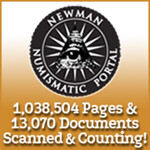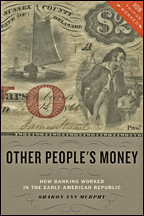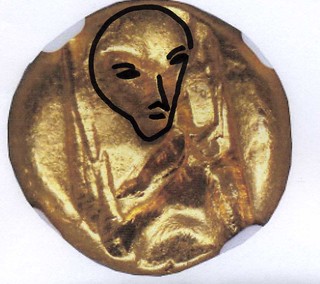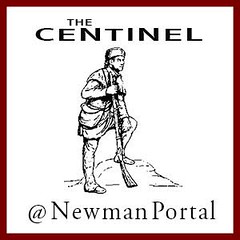
About UsThe Numismatic Bibliomania Society is a non-profit organization devoted to the study and enjoyment of numismatic literature. For more information please see our web site at coinbooks.org SubscriptionsThose wishing to become new E-Sylum subscribers (or wishing to Unsubscribe) can go to the following web page link MembershipThere is a membership application available on the web site Membership Application To join, print the application and return it with your check to the address printed on the application. Print/Digital membership is $40 to addresses in the U.S., and $60 elsewhere. A digital-only membership is available for $25. For those without web access, write to: Terry White, Treasurer
AsylumFor Asylum mailing address changes and other membership questions, contact Terry at this email address: terrywhite5475@yahoo.com SubmissionsTo submit items for publication in The E-Sylum, just Reply to this message, or write to the Editor at this address: whomren@gmail.com BUY THE BOOK BEFORE THE COINSale Calendar
|
- WAYNE'S WORDS: THE E-SYLUM MAY 28, 2017
- KOLBE & FANNING BUY OR BID SALE CLOSES JUNE 3, 2017
- NEW BOOKS: SEARCH & SAVE DIMES, QUARTERS, HALVES
- WHITMAN OFFERS FREE KENNEDY COLLECTIBLES BOOK
- NEW BOOK: OTHER PEOPLE'S MONEY
- NEW BOOK: THE PELLA FIND
- NEW BOOK: FROM ASCALON TO RAFIA
- BOOK REVIEW: PRAISE OF NUMISMATICS
- NEW BOOK COLLECTING PRIZE FOR YOUNG WOMEN
- LONG-LOST JOSEPH MICKLEY LETTER REDISCOVERED
- PNG ADDS JAMES EARL JONES COLLECTING VIDEOS
- BOWERS ON LORE AND LURE OF AMERICAN MEDALS
- NORWAY'S BIZARRE COD BANKNOTE VIDEO
- NOTES FROM E-SYLUM READERS: MAY 28, 2017
- QUERY: WHO WAS M WALKER?
- HISTORY OF THE US MINT’S LOCATIONS
- U.S. MINT DISCONTINUES MAIL ORDERS
- VOCABULARY TERM: WIPE MARKS
- FRANCIS XAVIER LE PERE (1822-1906)
- BENJAMIN BELL (1976-2017)
- MORE ON RUSS SEARS
- MORE ON CATHERINE BULLOWA-MOORE
- COINSWEEKLY BIOGRAPHY: KERRY WETTERSTROM
- ERIC P. NEWMAN CELEBRATES 106TH BIRTHDAY
- PROBLEMS WITH RIO OLYMPICS ECO-FRIENDLY MEDALS
- SAWYER NATIVE AMERICANS MEDAL GALVANOS
- HERITAGE JUNE 2017 HONG KONG SALE SELECTIONS
- HISTORY OF THE KWIK LOK BREAD TAG COMPANY
- FAKE 1974 ALUMINUM CENTS OFFERED ON EBAY
- ANS REPATRIATES LOOTED COINS TO SALZBURG MUSEUM
- 1765 RUSSIAN COIN FOUND ON NOVA SCOTIA BEACH
- 17TH CENTURY GOLD COIN FOUND IN MOSCOW RIVER
- MOSCOW IDAHO CHALLENGE COIN FOR SLAIN OFFICER
- THE 1978 SOUTH KOREAN COMMEMORATIVE COIN RIOT
- CHINESE PRACTICE NOTES CIRCULATED IN OHIO
- IS JANE AUSTEN'S BANKNOTE PORTRAIT TOO PRETTY?
- SWAMPFUL OF OLD SOVIET BANKNOTES FOUND
- GUNMEN SEIZE TRUCKLOAD OF YEMENI BANKNOTES
- MAN BALANCES BANKNOTE ON NOSE
- ART PROJECT PILES 15,000 COINS ON SIDEWALK
Click here to access the complete archive
To comment or submit articles, reply to whomren@gmail.com
Content presented in The E-Sylum is not necessarily researched or independently fact-checked, and views expressed do not necessarily represent those of the Numismatic Bibliomania Society.
WAYNE'S WORDS: THE E-SYLUM MAY 28, 2017
 New subscribers this week include: Brooke Martin, courtesy of Robert Hoge. Welcome aboard! After dropping some bad email addresses, we now have 3,249 subscribers.
New subscribers this week include: Brooke Martin, courtesy of Robert Hoge. Welcome aboard! After dropping some bad email addresses, we now have 3,249 subscribers.
Thank you for reading The E-Sylum. If you enjoy it, please send me the email addresses of friends you think may enjoy it as well and I'll send them a subscription with your compliments. Contact me at whomren@gmail.com anytime regarding your subscription, or questions, comments or suggestions about our content.
This week we open with a reminder about Kolbe & Fanning's current Buy or Bid sale, five new books and one review. Other topics this week include a long-lost Joseph Mickley letter, several new videos, the various locations of the U.S. Mint, collector Francis LePere, fake 1974 aluminum cents, and Chinese Practice Notes.
To learn more about John F. Kennedy medallic art, the copper coins of King Cassander, baggage tags, the 1851 Great Exhibition in London, U.S. Mint mail order catalogs, wipe marks, Edward Warren Sawyer's Native American medals, the Pavilion dollar, the South Korean commemorative coin riot, and the swamp of Soviet banknotes, read on. Have a great week, everyone!
Wayne Homren
Editor, The E-Sylum
KOLBE & FANNING BUY OR BID SALE CLOSES JUNE 3, 2017
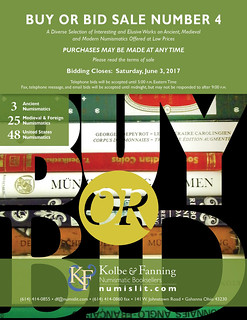 Kolbe & Fanning Numismatic Booksellers wish to remind everyone that our fourth “Buy or Bid” Sale will close on Saturday, June 3. Telephone bids will be accepted until 5 p.m., while email,
fax and voicemail bids will be accepted until midnight (though not necessarily responded to after 9 p.m.).
Kolbe & Fanning Numismatic Booksellers wish to remind everyone that our fourth “Buy or Bid” Sale will close on Saturday, June 3. Telephone bids will be accepted until 5 p.m., while email,
fax and voicemail bids will be accepted until midnight (though not necessarily responded to after 9 p.m.).
The sale focuses on modestly priced books, giving collectors an opportunity to add to their libraries at minimal cost. As the name of the sale suggests, customers may bid on items they wish to acquire or buy them outright at the published price. The Terms of Sale give full instructions on how to participate: please read it carefully.
The PDF catalogue is available for downloading from the Kolbe & Fanning website at numislit.com. There is no printed catalogue.
If you have any questions about the sale, please write the firm at orders@numislit.com. Thank you in advance for your participation. Download the sale today: numislit.com .
To read the earlier E-Sylum article, see:
KOLBE & FANNING BUY OR BID SALE CLOSES JUNE 3, 2017 (http://www.coinbooks.org/v20/esylum_v20n21a04.html)
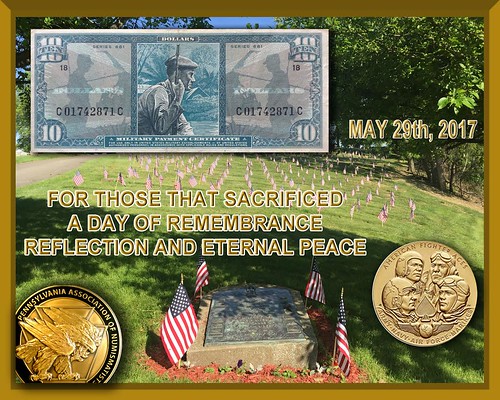
NEW BOOKS: SEARCH & SAVE DIMES, QUARTERS, HALVES
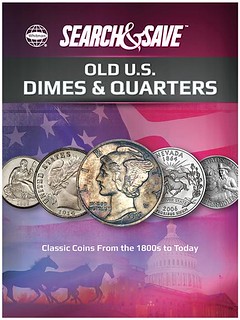
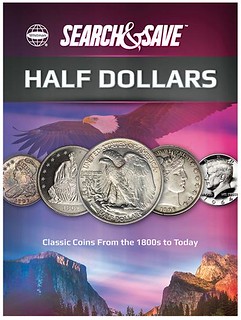
Whitman Publishing announces the release of two new volumes in its series of combination book-albums trademarked under the name Search & Save. Each new volume consists of a 96-page hardcover book bound with a Whitman Classic Coin Album page for storing and displaying a customized coin collection. The Search & Save volumes are intended for beginning to intermediate hobbyists, as a fun way to introduce newcomers to active coin collecting. Volume 5 covers dimes and quarters, and volume 6 covers half dollars. Each retails for $9.95 and is available from booksellers and hobby shops nationwide, and online (including at www.Whitman.com).
The Whitman Classic® Coin Album page has protective plastic slides that are inserted on each side of the page’s openings, holding each coin firmly in place while allowing its obverse and reverse to be displayed.
Many of the Search & Save coins can be collected from circulation. Others require some hunting at local coin shops, online, or at a coin show. The two new volumes discuss coins going back to the earliest years of the Philadelphia Mint, in the 1790s. Their album pages start with more common and easily collectible coins beginning with the Capped Bust types of the early 1800s.
“Readers of our Search & Save books learn about each coin in the context of American and world history, and enjoy the fun and pride of building their own valuable collections,” said Whitman publisher Dennis Tucker. “The books encourage readers to explore beyond their pocket change, to build relationships with coin dealers and go to coin shows. When they’re done, they not only have a personalized coin collection, but they can tell each coin’s story and share them with their friends and family.”
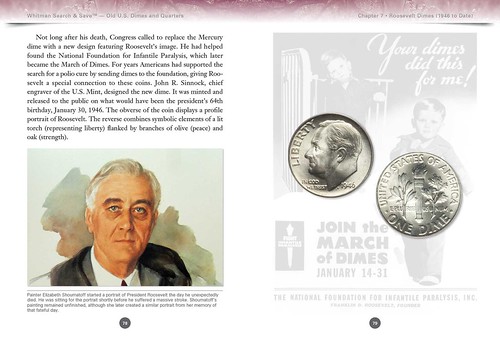
Search & Save: Old U.S. Dimes and Quarters begins with a richly illustrated chapter on the history of coinage in America. It includes chapters on Capped Bust, Liberty Seated, and Barber dimes and quarters of the 1800s and early 1900s, Mercury dimes, Standing Liberty quarters, Roosevelt dimes, and Washington quarters. A final chapter gives advice on collecting each coin type. The book’s album page provides openings to assemble a collection of 16 different coins dating from the early 1800s to today.
Search & Save: U.S. Half Dollars offers a colorful exploration of American commerce and coinage from the colonial era to the start of the Philadelphia Mint in 1792. Subsequent chapters cover Capped Bust, Liberty Seated, and Barber half dollars (spanning from 1807 to 1915), Liberty Walking half dollars, Franklin half dollars, and Kennedy half dollars. A special chapter explores the field of U.S. commemorative half dollars from 1892 to date, and a final chapter tells how to collect each coin type. The book’s album page allows the collector to display 12 coins of different types and varieties, ranging from Capped Bust half dollars of the early 1800s to today’s Kennedys, plus three of their favorite commemorative half dollars.
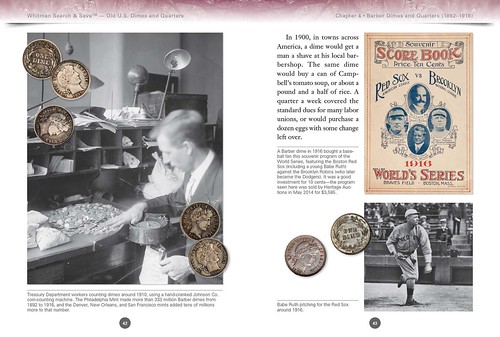
The first four Search & Save books covered Lincoln cents, nickels, State quarters, and America the Beautiful quarters.
Because Whitman Publishing is the Official Supplier of the American Numismatic Association, ANA members receive 10% off the Search & Save books when purchasing directly.
For more information, or to order, see:
www.whitman.com
WHITMAN OFFERS FREE KENNEDY COLLECTIBLES BOOK
 John F. Kennedy, the only American president ever honored on a circulating half dollar coin, was born May 29, 1917. To celebrate the 100th anniversary of his birth, Whitman Publishing is
offering a free copy of The Kennedy World in Medallic Art: John F. Kennedy and His Family in Medals, Coins, Tokens, and Other Collectibles, by William R. Rice, in a promotion throughout the
month of June.
John F. Kennedy, the only American president ever honored on a circulating half dollar coin, was born May 29, 1917. To celebrate the 100th anniversary of his birth, Whitman Publishing is
offering a free copy of The Kennedy World in Medallic Art: John F. Kennedy and His Family in Medals, Coins, Tokens, and Other Collectibles, by William R. Rice, in a promotion throughout the
month of June.
Normally The Kennedy World in Medallic Art is available from booksellers and hobby shops nationwide and online for $19.95. From May 29 through June 30, 2017, collectors who spend $25 or more at www.Whitman.com may request a free copy of the 304-page hardcover book by entering code JFK at checkout.
In this monumental book, Kennedy historian William Rice offers fresh insight on the life and times of the president. His exploration includes the history of the Kennedy family; JFK’s boyhood; his military service and early political career; his inauguration and presidency; Jacqueline and the children; life in the White House; the November 1963 assassination; and the world’s mourning and remembrance.
The story is told through touching and insightful essays illustrated by more than 1,500 images including coins, medals, tokens, stamps, and other memorabilia. Many are popular and collectible, like the 1964 silver Kennedy half dollar (with its mintage of 429 million coins) and the recent best-selling 2014 gold Kennedy halves. Other items are rare and seldom seen, and some one-of-a-kind.
“John F. Kennedy is one of the most popular presidents in American history,” says Whitman publisher Dennis Tucker. “Edward Rochette and Aubrey Mayhew started numismatic studies of Kennedy in the 1960s, and William Rice builds on their foundation. Today’s collectors benefit from full-color images and 50 years of ongoing research. Savvy buyers can find many JFK coins, medals, and tokens at local coin shows, flea markets, antique malls, and online.”
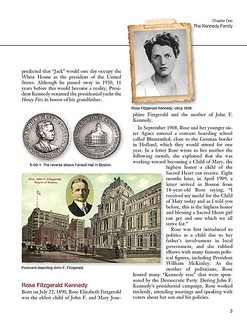
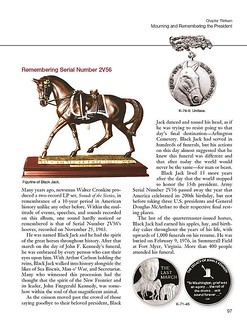
Special book sections discuss subjects like satirical and critical pieces; brothers Robert F. and Teddy Kennedy; the Peace Corps; and paper money issued during the Kennedy administration.
Military challenge coins are given extra attention (with more than 180 images) as are foreign and domestic “march” medals, commemorative postage covers, world coins, and medal sets. Rice discusses and illustrates Chinese Hell notes, carved hobo coins, Wedgwood pottery, silver bullion bars, elongated coins, and many of other categories of Kennedy collectibles.
In addition to colorful historical images and narrative, the book’s scholarly appeal is expanded by multiple appendices, a bibliography, and a full index. Collectors benefit from the catalog numbering system and commentary on today’s buy-sell-trade market. A 52-page appendix catalogs more than 2,670 individual items by date, size, composition, and description.
“Historians will remain deeply indebted to William Rice for his gigantic addition to the field of John F. Kennedy medallic art and related historical memorabilia,” says noted Kennedy historian Dr. Gerald J. Steinberg.
The Kennedy World in Medallic Art: John F. Kennedy and His Family in Medals, Coins, Tokens, and Other Collectibles
By William R. Rice; foreword by Dr. Gerald J. Steinberg
ISBN 0794842364
Hardcover, 8.5 x 11 inches · 304 pages · Full color
Retail $19.95 U.S.

NEW BOOK: OTHER PEOPLE'S MONEY
- PROLOGUE. How the Bank War Worked
- How Money Worked: Revolutionary America
- How Banks Worked: The Early Republic
- How Panics Worked: The Era of the Bank War
- Experiments in Money and Banking: Antebellum America
- How Civil War Finance Worked: The Creation of the National Banking System
- CONCLUSION. Andrew Jackson, Other People’s Money, and the Creation of the Federal Reserve
- EPILOGUE. Why Is
Andrew JacksonHarriet Tubman on the $20 Bill?
Pieces of paper that claimed to be good for two dollars upon redemption at a distant bank. Foreign coins that fluctuated in value from town to town. Stock certificates issued by turnpike or canal companies—worth something... or perhaps nothing. IOUs from farmers or tradesmen, passed around by people who could not know the person who first issued them. Money and banking in antebellum America offered a glaring example of free-market capitalism run amok—unregulated, exuberant, and heading pell-mell toward the next "panic" of burst bubbles and hard times.
In Other People’s Money, Sharon Ann Murphy explains how banking and money worked before the federal government, spurred by the chaos of the Civil War, created the national system of US paper currency. Murphy traces the evolution of banking in America from the founding of the nation, when politicians debated the constitutionality of chartering a national bank, to Andrew Jackson’s role in the Bank War of the early 1830s, to the problems of financing a large-scale war. She reveals how, ultimately, the monetary and banking structures that emerged from the Civil War also provided the basis for our modern financial system, from its formation under the Federal Reserve in 1913 to the present.
Touching on the significant role that numerous historical figures played in shaping American banking—including Alexander Hamilton, James Madison, Benjamin Franklin, Henry Clay, Daniel Webster, and Louis Brandeis— Other People’s Money is an engaging guide to the heated political fights that surrounded banking in early America as well as to the economic causes and consequences of the financial system that emerged from the turmoil. By helping readers understand the financial history of this period and the way banking shaped the society in which ordinary Americans lived and worked, this book broadens and deepens our knowledge of the Early American Republic.
Sharon Ann Murphy is a professor of history at Providence College. She is the author of Investing in Life: Insurance in Antebellum America.
"A concise, approachable, and well-organized discussion of US banking up to the Civil War. Murphy clearly explains the mechanics and politics of banking in early America."
— Howard Bodenhorn, author of A History of Banking in Antebellum America: Financial Markets and Economic Development in an Era of Nation-Building
"Logical and coherent, Other People's Money makes eminent sense. It fills a serious void and will be a welcome guidebook to the complicated history of money and banking in this era."
— Stephen Mihm, author of A Nation of Counterfeiters: Capitalists, Con Men, and the Making of the United States
Paperback
208 pages
20 b&w illus.
ISBN: 9781421421759
February 2017
$19.95
For more information, or to order, see:
Other People's Money (https://jhupbooks.press.jhu.edu/content/other-peoples-money)
THE BOOK BAZARRE
NEW BOOK: THE PELLA FIND
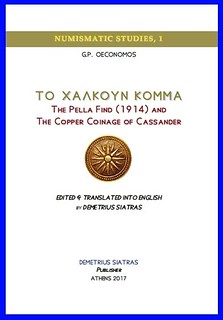 G.P. Oeconomos (1883-1951)
G.P. Oeconomos (1883-1951)
TO XAΛΚΟΥΝ ΚΟΜΜA - THE PELLA FIND (1914) AND THE COPPER COINAGE OF CASSANDER
Athens: Siatras, 2017.
First English edition.
Hard cover + jacket,
24 cm, 72 pp., ill. (3 plates).
Presents and discusses the copper coins of King Cassander of the 1914 hoard, found at Pella. ISBN: 978-618-82459-5-2. ΕUR 48.00 - FREE SHIPPING WORLDWIDE.
For more information, or to order, see: http://booksoncoins.blogspot.gr/
NEW BOOK: FROM ASCALON TO RAFIA
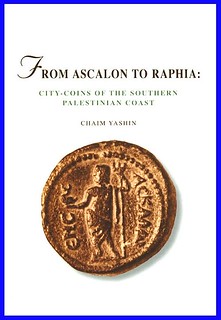 Chaim Yashin
Chaim Yashin
From Ascalon to Rafia: City-Coins of the Southern Palestinian Coast
In English. Hard cover, 25 cm, 112 pp. + 27 plates (519 coins). Bibliography.
This attractive volume comprises the author’s personal coin collection. Born in Poland, Yashin came to Palestine in 1942. A resident of Ashqelon, he began collecting coins in the 1950s, and specialized in the mints of Ascalon, Gaza, Raphia and Anthedon. Perhaps the best collection of these mints’ coins in Israel, Yashin prepared a full catalogue of the results of a lifetime of collecting, completing it before his death in 2002.
The book was posthumously published. It includes 519 detailed catalogue entries (Ascalon, 271; Gaza, 214; Raphia, 31; and Anthedon, 3), covering the full range of minting of these cities, from the Persian period (end of the 5fth century BC) to the Umayyad period (8th century AD). Almost all of the coins are illustrated in 27 plates of quality black and white photographs. The collection contains many new variants, and probably is the most comprehensive report of the coins of these four mints published to date.
ΕUR 68.00 + Shipping cost EUR 9.80
For more information, or to order, see: http://booksoncoins.blogspot.gr/
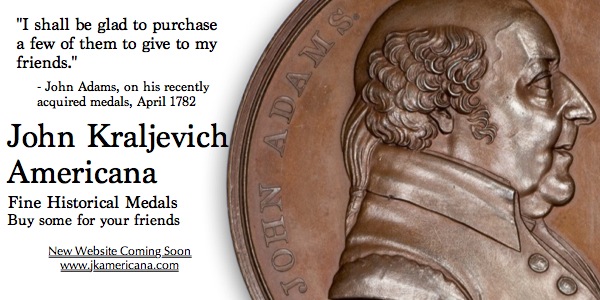
BOOK REVIEW: PRAISE OF NUMISMATICS
 Praise of numismatics. Elogium nummophiliae
Praise of numismatics. Elogium nummophiliae
Damiano Cappellari
Publisher : AlboVersorio
Year of issue: 2015
Pages: 200 p., Ill. , Paperback
EAN: 9788899029111
The goal of this work is the praise of numismatics, but perhaps more than nummophilia, which is the vibrant vibration of joy that shines in the eyes and waves in the chest of the nummophiles (that is, antique coin amateurs). Damiano Cappellari, in an original way, tells centuries of history in which the passion for coins accounted for more money
For more information, or to order, see:
Elogio della numismatica. Elogium nummophiliae (https://www.ibs.it/elogio-della-numismatica-elogium-nummophiliae-libro-damiano-cappellari/e/9788899029111)
Do you know Guillaume Apollinaire’s ‘The Flâneur of Paris’? At the beginning of the 20th century, artists still took the time to wander through their urban environment without any particular aim, to be inspired by their surroundings, to gather impressions. And sometimes they immortalized this strolling in a literal form, as Apollinaire did. I felt reminded of this when I read the curious book ‘Elogio della numismatica’ by Damiano Cappellari.
Right at the start, I noticed two things. Firstly, the table of contents doesn’t reveal any content structure. And secondly, the book is written in an Italian language that is often poetic, sometimes self-mocking, and always sounds like a slightly out of date scholarly high-level language, recalling the great masters of the past.
In his second book, the young Italian explains why he wants to distinguish between ‘numismatics’ and ‘nummophilia’: While numismatics can also be pursued as pure science without any emotions, with nummophilia he rather emphasizes the enthusiasm for coins that opens up whole new worlds for the relevant followers. By that the author of course polemizes. Yet you don’t hold this against him for there is one element that runs through his book like a recurring theme, so undividedly excited and exciting: the love for coins.
The quotations make it clear – this is not a numismatic book, which can be classified according to any common pattern. It thrives on its enchanting language and can be described more appropriately on the basis of what it does not do: This Elogium is not an introduction to numismatics, no analysis of a historical subject-matter, not a manual or a catalog. It’s nothing less than a declaration of love. And similarly to the love between people, within the front cover and the back, this booklet evidences that the love for coins also has no meaning (and doesn’t have to have), it simply is.
To read the complete CoinsWeekly article, see:
Praise of coin enthusiasm or: strolling through the world of
numismatics (http://www.coinsweekly.com/en/News/Praise-of-coin-enthusiasm-or-strolling-through-the-world-of-numismatics/4?&id=4718)
For a free subscription to CoinsWeekly, see: http://www.coinsweekly.com/en/Subscribe-to-CoinsWeekly-Newsletter/37
NEW BOOK COLLECTING PRIZE FOR YOUNG WOMEN
 Exciting news for young female book collectors: Brooklyn’s Honey & Wax Booksellers has announced an annual prize of $1,000 to be awarded to a woman aged 30 or younger with an “outstanding
book collection.” The collection can include books, manuscripts, and/or ephemera, organized by whatever principle the collector deems appropriate to the material.
Exciting news for young female book collectors: Brooklyn’s Honey & Wax Booksellers has announced an annual prize of $1,000 to be awarded to a woman aged 30 or younger with an “outstanding
book collection.” The collection can include books, manuscripts, and/or ephemera, organized by whatever principle the collector deems appropriate to the material.
Honey & Wax booksellers Heather O’Donnell and Rebecca Romney, pictured here at the New York Antiquarian Book Fair last year, took some inspiration for the collecting prize from the American book collector Mary Hyde Eccles. “Rebecca and I are both interested in the historic role of women in the rare book trade, on both the buying and the selling sides, and want to do whatever we can to get younger women involved,” said O’Donnell.
The Honey & Wax Book Collecting Prize “rewards creativity, coherence, and bibliographic rigor,” according to the announcement, and “collections will not be judged on their size or their market value.” Entrants need not be enrolled in a degree program, a significant difference from similar collecting contests, and one that opens it up to a broader range of applicants. As O’Donnell said, “We want to give those women who have applied to their college book collecting contests and/or to the National Collegiate contest an additional chance to be recognized for their work, and we’d also like to reach out to bookish young women outside the academy.”
The deadline is July 15.
To read the complete article, see:
New Book Collecting Prize for Women
(https://www.finebooksmagazine.com/fine_books_blog/2017/05/new-book-collecting-prize-for-women.phtml)

LONG-LOST JOSEPH MICKLEY LETTER REDISCOVERED
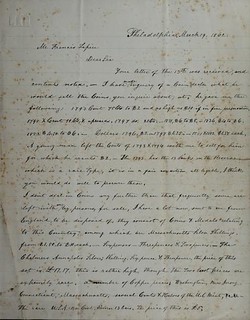
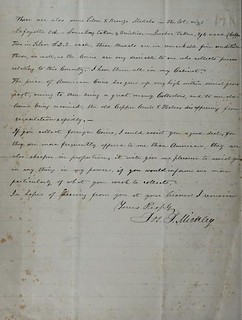
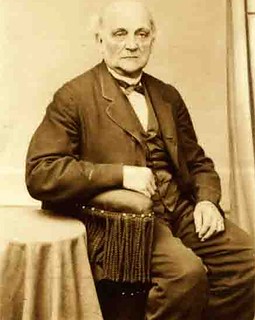 In organizing the Eric P. Newman papers, we located an original letter from the important Philadelphia collector Joseph Mickley to Francis Lepire, dated March 19, 1862. Mickley offers a
variety of coins at varying prices but more importantly comments on the growth of the coin market following the disappearance of large cents, in addition to the Coinage Act of 1853, which reduced the
silver content of U.S. coinage. Mickley suggests that medals and foreign coins might be easier to pursue than American coins, and does nothing to mask his interest in selling the former. Newman
published this letter in Coin World, 10/29/1969, but, to our knowledge, it has not been seen since then.
In organizing the Eric P. Newman papers, we located an original letter from the important Philadelphia collector Joseph Mickley to Francis Lepire, dated March 19, 1862. Mickley offers a
variety of coins at varying prices but more importantly comments on the growth of the coin market following the disappearance of large cents, in addition to the Coinage Act of 1853, which reduced the
silver content of U.S. coinage. Mickley suggests that medals and foreign coins might be easier to pursue than American coins, and does nothing to mask his interest in selling the former. Newman
published this letter in Coin World, 10/29/1969, but, to our knowledge, it has not been seen since then.
Transcription is as follows:
Your letter of the 13th was received and contents noted. I have made inquiry of a Coin dealer, what he would sell the coins you inquire about, at. He gave me the following. 1793 Cent 75 Cts to $2 and as high as $10 if in fine preservation, 1795 ½ Cent, 50 Ct, $1 upwards, 1797 do. 25 cts, - 1831, $6 to $8, 1836 $4 to $6, 1852 $4.50 to $6 – Dollars 1796, $2 – 1797 $1.25, - 1801 & 1802 1.50 each.
A young man left the Cents of 1793 & 1794 with me to sell for him for which he wants $2. The 1793 has the 13 links on the Reverse, which is a rare Type, it is in a fair condition, all legible, I think you would do well to procure these.
I don’t deal in coins any further than that frequently some are left with me by persons, for sale. I have a lot now, sent to me from England, to be disposed of, they consist of Coins and medals relating to this Country, among which are Massachusetts Silver Shillings, from $1.50 to $10 each, - Sixpences – Threepences & twopences. – The Chalmers Annapolis Silver Shilling, Sixpence & Threepence, the price of this is 17 pounds 17 shillings, this is rather high, though the last two pieces are extremely rare, a number of Copper pieces: Washington, New Jersey, Connecticut, Massachusetts, several Cents & Halves of the U.S. Mint, etc., etc., - The rare U.S.A. Bar Cent Reverse 13 bars. The price of this is five pounds.
There are also some Silver & Bronze Medals in the lot, viz: Lafayette 5th – Louisburg taken, 2 varieties, - Quebec taken 8/6 each (copper.) Two in Silver, 2 pounds 2 shillings each, these medals are in remarkable fine condition. These, as well as the coins, are very desirable to one who collects pieces relating to this country. I have them all in my cabinet.
The price of American coins has gone up very high within several years past, owing to there being a great many Collectors and to our old coins being recoined, the old Copper Cents and Halves disappearing from circulation rapidly.
If you‘ve a collection of foreign Coins, I would assist you a great deal, for they are more frequently offered to me than American, they are also cheaper in proportion, it will give me pleasure to assist you in anything in my power, if you would inform me more particularly of what you wish to collect.
In hopes of hearing from you at your leisure, I remain
Yours Resply.
Jos. J. Mickley.
Link to Mickley letter on Newman Portal:
https://nnp.wustl.edu/library/archivedetail/1371
PNG ADDS JAMES EARL JONES COLLECTING VIDEOS
The award-winning educational video, “Money: History in Your Hands,” narrated by acclaimed actor James Earl Jones, now is available for free viewing on the Professional Numismatists Guild YouTube.com channel.
“We currently have more than a dozen videos about rare coins, paper money and precious metals available for complimentary viewing on PNG’s YouTube channel. They will be helpful for beginners to advanced collectors and investors with informative advice about buying, storing and selling numismatic items as well as gold, silver and platinum bullion items,” said PNG Executive Director Robert Brueggeman.
“An important part of our educational effort is the video, ‘Money: History in Your Hands,’ jointly created by PNG and the American Numismatic Association, and hosted on camera by James Earl Jones. It gives viewers a compelling overview of the history of money, and how it relates to art, culture, history, politics and religion,” explained Brueggeman. “The 29-minute video is available for convenient viewing in two parts.”
Other informative PNG videos focus on topics of discovering the enjoyment of coin collecting, how to determine the value of your coins, and the importance of working with a reputable,
knowledgeable dealer when you buy or sell. All of the videos are can be viewed at:
https://www.youtube.com/channel/UCb5co6ZLKPitRAw-6pDxeCw
If you have a numismatic web site or email list, consider linking to and promoting the videos.
While the PNG YouTube channel is brand new, the Jones videos are not. I reached out to PNG Public Relations contact Donn Pearlman for more information. -Editor
Donn Pearlman writes:
This is the same "Money: History In Your Hands" program that was shown on many PBS TV stations some years ago. I was involved in getting it distributed nationwide and placed through WTTW-TV in Chicago. I also wrote the script for the original video.
I had already started about four or five pages of script when I was informed that James Earl Jones had agreed to be the on-camera host and do the voice-over narration. I immediately ripped up my initial writing and started again with his voice in my head.
I completely rewrote the video's opening segment so that viewers would see a montage of different kinds of money and hear Mr. Jones voice reading a list of slang terms for money. His final word is, "Moola."
To read the earlier E-Sylum article, see:
MORE CELEBRITY NUMISMATISTS (http://www.coinbooks.org/esylum_v03n22a04.html)
AUCTION CATALOGS FOR SALE
My asking price is $4500 for the lot. The majority of the catalogs are US sales (about 70%) the remainder are Foreign (about 30%), all are better sales. There are multiples of most of the US catalogs and of some of the foreign sales, a total of nearly five thousand catalogs. Anyone interested should feel free to inquire and discuss potential purchase.
BOWERS ON LORE AND LURE OF AMERICAN MEDALS
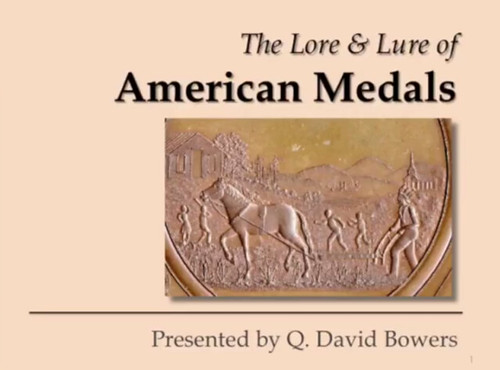
Medal Collectors of America (MCA) President Skyler Liechty writes:
In January 2016 Q. David Bowers was the keynote speaker at the Medal Collectors of America's meeting at the NYINC. The standing room only crowd heard his riveting presentation entitled The Lore and Lure of Medals. For anyone who missed it the MCA is please to make the video version available on YouTube.
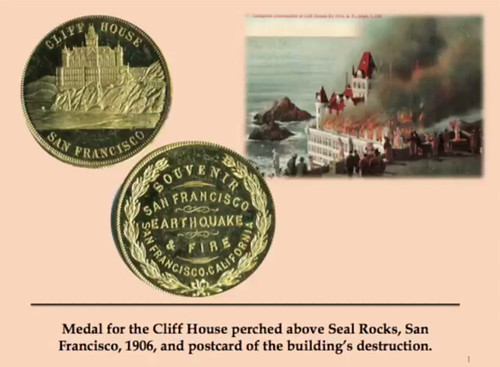
To view the complete video, see:
Q. David Bowers - The Lore & Lure of American Medals (https://www.youtube.com/watch?v=jcpKz7bzX04)
NORWAY'S BIZARRE COD BANKNOTE VIDEO
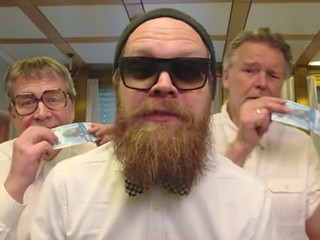 Norway's central bank has released a bizarre music video promoting the imminent launch of its new banknotes, which feature the national fish, the cod, on them.
Norway's central bank has released a bizarre music video promoting the imminent launch of its new banknotes, which feature the national fish, the cod, on them.
Norwegian comedy trio KLM feature in the video, released by Norges Bank, singing about the launch of the new "Cod Kroner" to the tune of "I Will Follow Him," the pop song best known for featuring in Sister Act.
KLM have already recorded a spoof of the song with the title "The Cod is Coming" and it appears that the spoof has been updated to celebrate the new notes.
To read the complete article, see:
Norway's central bank has made a bizarre music video to celebrate its new 'cod'
banknotes (http://www.businessinsider.com/norwegian-central-banks-music-video-for-new-cod-banknotes-2017-5)
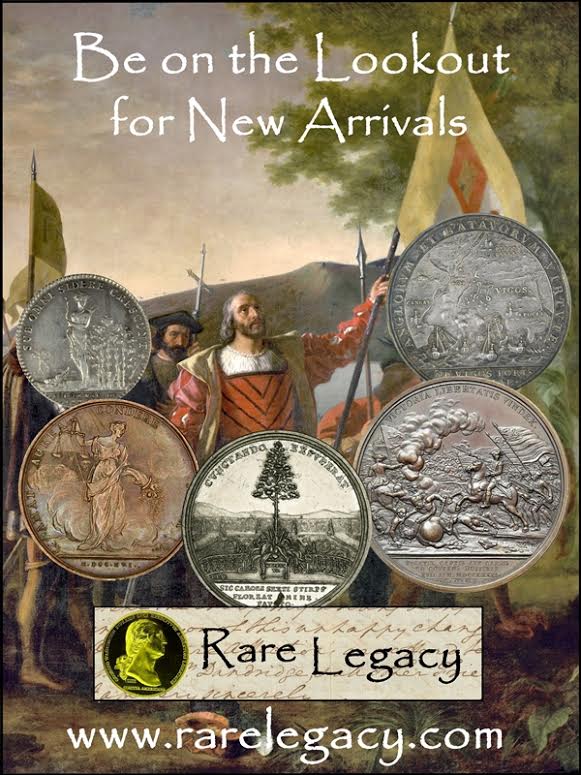
NOTES FROM E-SYLUM READERS: MAY 28, 2017
On the Candidates for NBS Elections
Regarding the slate of candidates for the Numismatic Bibliomania Society' upcoming election, Dave Bowers writes:
What a super slate of officers. The Board should be expanded, if needed, to accommodate them all! A gathering of eagles!
To read the earlier E-Sylum article, see:
2017 NBS ELECTION CANDIDATES (http://www.coinbooks.org/v20/esylum_v20n21a03.html)
More On the Mystery Item Struck on Civil War Token
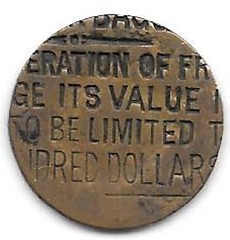
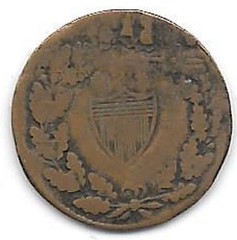
Regarding the unusual piece Bill Miller of Denton, MD asked about, Jeff Rock writes:
A fruitful avenue of research would be to check into luggage or baggage tags (and indeed the word at the top of the token looks like it could be 'baggage'. There was a 1913-1914 court case of Boston Railroad vs. Hooker which actually states "Baggage liability is limited to personal baggage not to exceed one hundred dollars in value for a passenger" which reads pretty darned close to what is visible on the token itself.
BARSTOW V. NEW YORK, NEW HAVEN H.R.R. CO (https://casetext.com/case/barstow-v-new-york-new-haven-hrr-co)
Boston & Maine R. Co. v. Hooker 233 U.S. 97 (1914) (https://supreme.justia.com/cases/federal/us/233/97/case.html)
Symposium On The Allure Of Tokens And Medals
Susan Trask writes:
The Civil War Token Society (CWTS), Token and Medal Society (TAMS) and Medal Collectors of America (MCA) are hosting a Money Talks presentation on Thursday, 3:00 pm at the American Numismatic Association in Denver this August titled ASK THE EXPERTS! A SYMPOSIUM ON THE ALLURE OF TOKENS AND MEDALS. I'm moderating a panel featuring David Schenkman, Bill Hyder, Steve Hayden, Neil Musante and Q. David Bowers. We would love your readers to submit their questions for the event to me via email at susantrask@mindspring.com or write to me at P.O. Box 2053, Sister, Or. 97759.
What a stellar panel! Here are a few of my own (deliberately provocative) questions on the topic.
- Why hasn't somebody written the Red Book of U.S. Medals?
- Or the MEGA Red of U.S. Tokens?
- TAMS was originally founded to include Paper Money collectors, but that faction soon split off to form the Society of Paper Money Collectors (SPMC). Now that there are national specialized groups for medals (like MCA) and tokens (like NTCA, the National Token Collectors Association), does TAMS still have a need to exist?
Query: Mayflower Medal Marking
Jim Duncan of New Zealand writes:
A colleague has a Mayflower medallion, silver, 1620-1970. Obverse the ship, reverse a map of east coast America. He is curious about some edge marking - STERLING H d over m 70P 02896.
The 'sterling' is obvious, but not much else, capital H, lowercase d over lowercase m? That's all greek to me. Can someone help?
On Numismatic Investment Returns
Regarding the Economist article on investment returns in tangible alternative asset classes, Bill Eckberg writes:
I, too, have studied the “investment returns” on coins, specifically US early coppers. The main finding was that you can make coins look like a fabulous or very poor investment by cherrypicking your starting and ending dates. Yes, generally prices rise, but there always seem to be several years of stagnation between price increases. The result of that is that you can make coins look like a fabulous investment or a poor one depending on what dates you choose to begin and end your study. Because of this, all such studies are biased.
Of course, any study of coin price performance over time has another important flaw: it has zero predictive power.
So, collect coins because you enjoy them. If you’re lucky, you might buy and sell at favorable points in the cycle. Of course, collectors collect over a period of time, so it is highly unlikely that the bulk of your collection will have been bought at a favorable point in the cycle. You can protect yourself somewhat by buying series that have a strong collector base and by buying quality within a grade/price range, but luck is a key to successful “investing" in coins.
Finally, please let me indulge my personal pet peeve a propos price/performance plots (and my love for alliteration). For some reason, too many of them are shown on linear scales. They mean nothing unless they are plotted on a semi-log scale. A change from $1-2 is exactly the same rate of return as a change from $1M-2M.
To read the earlier E-Sylum article, see:
STUDY EXAMINES RARE COIN INVESTMENT RETURNS (http://www.coinbooks.org/v20/esylum_v20n21a19.html)
Young America Furnace Company Note Misprint
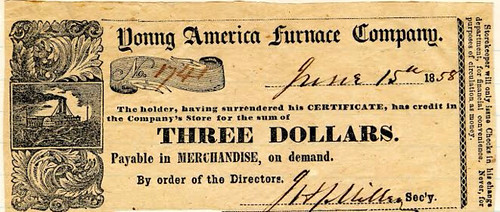
Philip Mernick of London writes:
 I may have missed it but I don’t see anywhere in your items on the Young America Furnace Company notes the fact that the top note seems to mis-printed. It has an upside down “n” in the
title making it 'Yonng' rather than 'Young'.
I may have missed it but I don’t see anywhere in your items on the Young America Furnace Company notes the fact that the top note seems to mis-printed. It has an upside down “n” in the
title making it 'Yonng' rather than 'Young'.
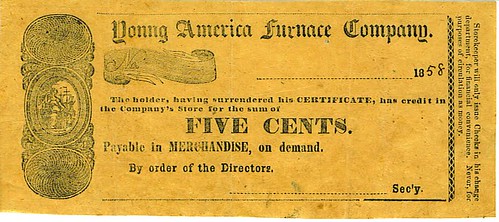
Dave adds:
The error also appears on the 5 cent denomination.
To read the earlier E-Sylum article, see:
WAYNE'S NUMISMATIC DIARY: MAY 14, 2017 : Young America Furnace Company Notes
(http://www.coinbooks.org/v20/esylum_v20n20a17.html)
Ancient Persian Coin Proves Aliens Exist
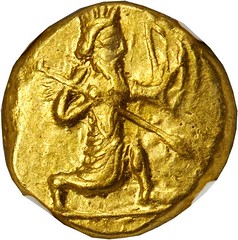
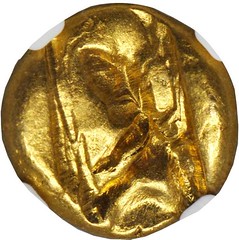
PERSIA. Achaemenidae. Xerxes II to Artaxerxes II, ca. 420-375 B.C. AV Daric (8.33 gms).
Besides the interesting articles I usually find something worthy of reprinting (with permission of course) in The Shekel. But this time I found something else--it sure looks like ET peeking out, with a spidery body, on the reverse of a daric. Did anyone else spot this?
To read the earlier E-Sylum article, see:
STACK'S BOWERS MAY 2017 WORLD ONLINE AUCTION (http://www.coinbooks.org/v20/esylum_v20n19a19.html)
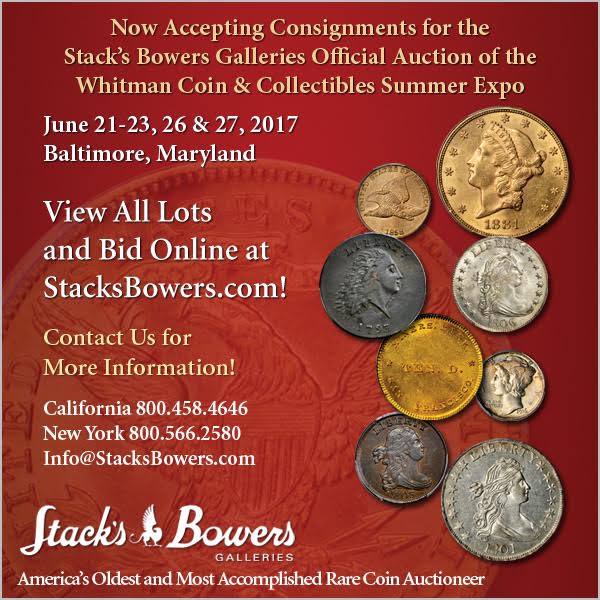
QUERY: WHO WAS M WALKER?
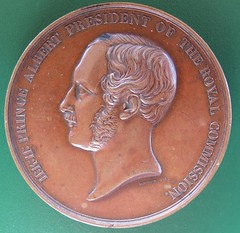

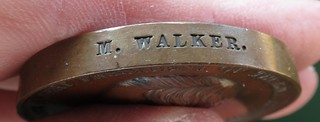 The 1851 Great Exhibition in London, and its medals have long been a passion of mine. I recently acquired a "For Services" medal named to an M. Walker. It turns out he was a
member of the US Committee that organized the American participation in the exhibition. I am having difficulty finding out much of anything about who he was, even his full name.
The 1851 Great Exhibition in London, and its medals have long been a passion of mine. I recently acquired a "For Services" medal named to an M. Walker. It turns out he was a
member of the US Committee that organized the American participation in the exhibition. I am having difficulty finding out much of anything about who he was, even his full name.
The First Report of the Commissioners for the Exhibition of 1851 (London: 1852, Her Majesty’s Stationery Office), Appendix V, page 45, Executive Organization, Foreign Arrangements, has:
“America (United States of) – Commissioner, Edward Riddle; Secretaries, Messrs. N.S. Dodge and Morey; Clerks, Messrs. Brewster and Walker; Attendants, 3.” This is the only Walker who received a For Services medal so he is my man
World’s Fairs from London 1851 to Chicago 1893 … by C.B. Norton (p. 64) states: “The United States was represented by a Commissioner, Edward Riddle, Esq., of Boston; secretaries, Messrs. Dodge and Morey; clerks, Messrs. Brewster and Walker, and three assistants.”
I am hoping some reader might enlighten me, or perhaps point me to an information source that will help me begin my research into "M. Walker" - his full name, who he was and where he was from.
I also wonder if someone else out there has studied the 1851 Exhibition and has perhaps really gotten into the American presence there. Much has been written about the successes of the U.S. at the event (which were impressive) even though general opinion then was that the participation was a little "light" because the promotion of possible benefits to U.S. industry was not given much priority.
HISTORY OF THE US MINT’S LOCATIONS
A History of the US Mint’s Locations
 Throughout American history, the US Mint has operated facilities in nine US cities, as well as in Manila, the capital of the Philippines. Another was planned, but not completed, in the
state of Oregon. Six of these specialty manufacturing facilities were founded in response to gold or silver strikes in their regions, and many of them have become more iconic in their retirement than
when they were in full-scale operation.
Throughout American history, the US Mint has operated facilities in nine US cities, as well as in Manila, the capital of the Philippines. Another was planned, but not completed, in the
state of Oregon. Six of these specialty manufacturing facilities were founded in response to gold or silver strikes in their regions, and many of them have become more iconic in their retirement than
when they were in full-scale operation.
Following the American Revolution, government officials recognized the need for a standardized monetary system, and in 1781 the Articles of Confederation gave both Congress and the states the right to produce coins. However, none of the multiple varieties of coins struck by the federal or state governments or their authorized contractors achieved widespread circulation.
In 1789, the US Constitution gave Congress the exclusive power to coin money, but it still took several years of study and deliberation before that body passed the first of many Coinage Acts. The new monetary system that law created was based largely on Secretary of the Treasury Alexander Hamilton’s January 1791 “Report on the Establishment of a Mint.” The April 1792 Coinage Act was officially named “An Act establishing a mint, and regulating the Coins of the United States.” It designated the US dollar as the standard unit of money, established the US Mint, authorized the production of coins in denominations ranging from a half cent ($0.005) to an eagle ($10) and detailed the standards for the production of America’s coins.
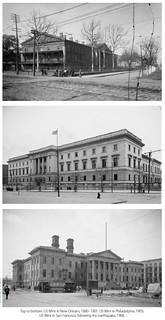 Since Philadelphia was the nation’s capital and its largest population center, it made sense to locate the first US Mint in that city. In July 1792, President George Washington appointed
former Pennsylvania Treasurer David Rittenhouse as the first director of the Mint. Later that month, Rittenhouse purchased two properties on Seventh Street and laid the cornerstone of the first
public building to be constructed by the United States.
Since Philadelphia was the nation’s capital and its largest population center, it made sense to locate the first US Mint in that city. In July 1792, President George Washington appointed
former Pennsylvania Treasurer David Rittenhouse as the first director of the Mint. Later that month, Rittenhouse purchased two properties on Seventh Street and laid the cornerstone of the first
public building to be constructed by the United States.
The first mint building was completed in September 1792, and two others followed in the next few months. The mint began producing copper coins in 1793; it added silver coins in 1794 and gold coins in 1795. The growing population’s strong demand for coins prompted the government to construct a larger production facility at the corner of Chestnut and Juniper Streets in Philadelphia in 1833.
To ease production bottlenecks and meet the demand for coinage, President Andrew Jackson signed The Mint Act of 1835, which authorized the establishment of US Mint branches in Charlotte, North Carolina; Dahlonega, Georgia; and New Orleans, Louisiana. All three of these branches had rather limited lives. They were seized by the Confederate government during the Civil War, with officials continuing to produce coins for a short time. After the war, the US government decided to close the Charlotte and Dahlonega facilities. But in 1876, it gave the New Orleans branch another chance at life by reopening it as an assay office. In 1879, after refurbishing its minting equipment, officials re-commissioned the facility as a producer of silver coins. For the next 25 years, it was the largest producer of the famous Morgan silver dollar.
The discovery of gold in California prompted the government to open another branch of the US Mint in San Francisco in 1854. In its first year of operation, the San Francisco Mint turned $4 million in gold bullion into coins. Growing demand from the western states prompted the government to build a larger San Francisco facility in 1874. This unusual building featured an enclosed central courtyard with a well. Within several years, this mint was producing more than 60% of the country’s gold and silver coins; its vaults became the repository for nearly one-third of the nation’s gold reserves.
To read the complete issue, see:
https://view.joomag.com/financial-history-issue-121-spring-2017/0213067001495737251

U.S. MINT DISCONTINUES MAIL ORDERS
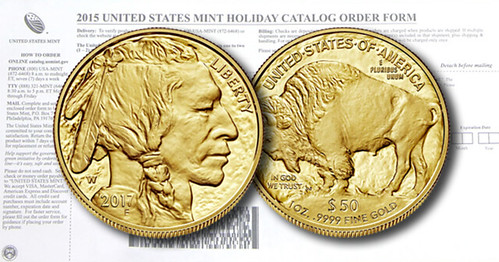
The U.S. Mint announced today that it is discontinuing all mail orders effective September 30, 2017.
The Mint will return any mail orders received after September 30 with instructions for placing orders online or by phone.
The consumer-products industry is increasingly adopting Web-based sales channels, including mobile applications, that give the public more efficient, cost-effective, and faster ways to purchase products. The Mint is following this trend in an effort to better serve all its customers, and provide a more convenient and consistent ordering experience.
Future orders will be accepted at the Mint’s online catalog at www.catalog.usmint.gov or via telephone at 1-800-USA-MINT (872-6468), seven days a week from 8 a.m. to midnight ET.
To read the complete article, see:
U.S. Mint renews plans to discontinue mail orders
(http://news.coinupdate.com/u-s-mint-renews-plans-to-discontinue-mail-orders/)
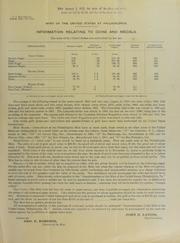 Newman Portal Project Coordinator Len Augsburger adds:
Newman Portal Project Coordinator Len Augsburger adds:
A group of the modern price lists would be welcome. We have some of the older U.S. Mint price lists with issue dates from 1866 to 1936.
To view the older Mint price lists on the Newman Portal, see:
https://nnp.wustl.edu/library/publisherdetail/512757
VOCABULARY TERM: WIPE MARKS


Streaks or blotches on this medal is an example of a patina anomaly. It was caused by an incorrect method of relieving as an early step of applying its finish. It was caused by using a rag instead of removing the darkening agent on a buffing wheel. It appears on all art medals made by the medal firm Davison Brothers of Philadelphia in the early 20th century. It can be removed by refinishing.
Wipe Marks. Dark streaks in the patina of a medal, as if wiped on with a rag; a patina anomaly. Also called FISHTAIL, it is a form of RESIDUAL TONING and is not a severe condition, as the streaks completely disappear when the medal is refinished. How they were caused is uncertain, but it is presumed they were the result of wiping off the darkening agent and relieved with a cloth instead of a buffing wheel. The streaks probably did not appear before the medals were lacquered, but sometimes afterwards (typical of residual toning). Virtually all the large medals produced by the firm Joseph K. Davison's Sons of Philadelphia from 1900 to 1915 exhibit this unsightly condition indicating this was their standard finishing procedure for large medals. Most prominent of these are the Gettysburg Monument Dedication Medal of 1910 and the Lincoln G.A.R. Medal of 1909 (King 321). Also wipe marks infrequently occur on medals of Davison's manufacture in the series Circle of the Friends of the Medallion (numbers three through eleven, 1911–14). CLASS 09.9
Looking for the meaning of a numismatic word, or the description of a term? Try the Newman Numismatic Portal's Numismatic Dictionary at: https://nnp.wustl.edu/library/dictionary
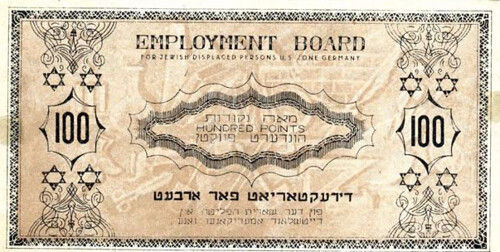
SELECTIONS FROM THE DR. ALAN YORK COLLECTION OF INTERNMENT CAMP AND RELATED PAPER MONEY INCLUDING 3 DIFFERENT NOTES FROM CAMP HAY, NUMEROUS WORLD WAR II RELATED NOTES FROM BRITAIN, ISLE OF MAN, ETC. PLUS A COMPLETE SET OF GIL GIL POW CAMP NOTES FROM KENYA
A NICE SELECTION OF WORLD COINS, TOKENS AND MEDALS IN ALL METALS INCLUDING: ANCIENT AND WORLD COINS INCLUDING MANY CERTIFIED COINS
THE EXCEEDINGLY RARE, AND PERHAPS FINEST KNOWN, 1947 1 MIL COIN OF PALESTINE
HIGH GRADE AND RARE WORLD COINS WITH MANY COINS FROM AFRICA: SOUTHERN RHODESIA 1932 PROOF SET SOUTHERN RHODESIA 1954 2 SHILLINGS OTHER RARITIES FROM SUDAN TO ZANZIBAR
JEWISH RELATED MEDALS, TOKENS AND PAPER MONEY AND MANY OTHER ITEMS
Catalogs will be mailed early to mid-June, send $10 for printed copy or check our website for color images. The sale should be up on our website in early June as well.
LOT VIEWING at Kansas City International Paper Money Show June 8-10, Colorado Springs Coin Show during the break from the ANA Summer Seminar June 21-24.
P.O. Box 785, Littleton, CO 80160-0785
Phone-720-981-0785 Fax-720-981-5345
Cell phone 303 910 8245
Bill@Rosenblumcoins.com
www.rosenblumcoins.com
FRANCIS XAVIER LE PERE (1822-1906)
Francis Xavier Le Pere (1822-1906), also commonly spelled Lepère, was born the eldest of six children on September 7, 1822, son of Martin Le Père (1794-), an immigrant from Belgium, and a Grocer, and Elizabeth (1801-1884), a native of Kentucky.
Lepère owned a wholesale and retail grocery store in St. Louis, Missouri, and his clerk was James Edwin Love. He is also noted among glass collectors for glass bottles with Francis Leper molded in the glass, or Lepère & Richards, most probably manufactured by the Ellenville Glass Company. He was very successful and wealthy and had four domestic servants at his home.
He married Catherine M. Dyer (1828-), a native of Massachusetts, on 17 October 1848 in St. Louis, Missouri. They had at least nine children.
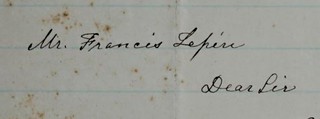 During the Civil War, March 1862, he wrote a letter of inquiry to Joseph Jacob Mickley of Philadelphia to investigate the market value of numismatic items in his collection. Mickley replied
on March 19, 1862 with a letter discovered by Eric P. Newman who first published it in Coin World, October 29, 1969.
During the Civil War, March 1862, he wrote a letter of inquiry to Joseph Jacob Mickley of Philadelphia to investigate the market value of numismatic items in his collection. Mickley replied
on March 19, 1862 with a letter discovered by Eric P. Newman who first published it in Coin World, October 29, 1969.
In the Lupia Numismatic Library there is another letter written postmarked March 26, 1862, sent by Charles Kimball of New York to his friend George Russell of Boston telling him he attended the Ed Cogan coin auction sale on Wednesday, March 26, 1862, at Bangs, Merwin & Company, New York City. He included newspaper clippings that discussed the contemporary situation of the Civil War affecting the coin market with the headline "Depreciation in the Prices of Coins, Medals, Etc., etc."
In December 1868, J. N. T. Levick remarked that Lepère and E. Richards, Jr., were among the noted American collectors of St. Louis, who collected Store Cards.
From July 17-18, 1876 he sold part of his coin collection at Thomas Birch & Sons, Philadelphia, catalogued by Captain John White Haseltine, as Centennial IV.
In 1893, he composed a libretto to the opera Jacinta written by Alfred G. Robyn.
From February 15-16, 1904, S. H. & H. Chapman sold part of his coin collection at Davis & Harvey, Philadelphia, together with M. L. Coleman, Rev. Jeremiah Zimmerman, Dr. W. E. Booker, and Charles S. Wilcox.
He died on January 8, 1906 at St. Louis, Missouri. He is buried at Calvary Cemetery and Mausoleum, Saint Louis, Missouri.
To read the complete article, see:
LE PÈRE, FRANCIS XAVIER
(https://sites.google.com/a/numismaticmall.com/www/numismaticmall-com/lepere-francis)
BENJAMIN BELL (1976-2017)
Regarding the article about dealer Benjamin Bell in the Summer 2017 issue of our print journal The Asylum, James Higby writes:
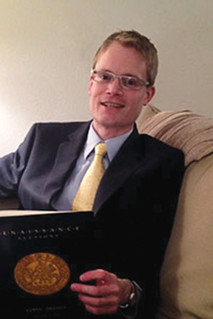 I saw the photo of Benjamin Bell in last week's E-Sylum. I presume that photo was from his new partnership in Arizona, announcing his passing on April 10, 2017. He was one of my
closest numismatic friends when he was partner with Josh Moran at Civitas Galleries in Middleton WI. He was my go-to person for both buying and selling world coins for the entire time he was
there.
I saw the photo of Benjamin Bell in last week's E-Sylum. I presume that photo was from his new partnership in Arizona, announcing his passing on April 10, 2017. He was one of my
closest numismatic friends when he was partner with Josh Moran at Civitas Galleries in Middleton WI. He was my go-to person for both buying and selling world coins for the entire time he was
there.
He was a rare personality who could talk many topics in depth. One time when I was visiting Civitas we got to discussing music, and he broke out his violin and played a song for me. Where else does that happen? His parents were avid prairie preservationists and had a tiny plot of native plants in front of the store that they tended when they came up from Washington IL to visit him. I shall mourn Ben's passing mightily.
Benjamin Bell
March 8, 1976 – April 10, 2017
Memories of a good friend...
I recently moved to Arizona to work full time at World Numismatics’ headquarters. These past few weeks have been very exciting for us, yet that joy has been clouded by the recent passing of our
colleague Benjamin Bell. Ben passed away on Monday, April 10, after a long, hard-fought battle with cancer, his loving family at his side. Well educated in traditional historic studies, Ben worked as
a numismatist at Classical Numismatic Group and was the co-founder, co-owner and President of Civitas Galleries, Ltd. In a world where many numismatists have grudges against one or more of their
colleagues, Ben was one of only a very few loved and respected by everyone, and was duly considered one of the rising stars in professional numismatics. By our great many conversations, I can attest
to his deep love of coins, extensive knowledge and impeccable work ethics. He was snatched far too soon from the coin world, and will be dearly missed. Our thoughts and prayers are with his parents,
Rob and Rebecca, and his sister Rachel.
—Carlos Jara
Ben was a client of ours for quite some time before I really started to get to know him. The first thing that struck me about him was that he had a universal appetite for books that resembled my
own. He’d always put together a small pile of books from our shelves when we’d see him at shows, and you’d never be able to guess what he’d select. While other customers were predictably focused on
U.S. or Greek or Russian coins, Ben read about everything numismatic. A book in German about Polish coins would be sandwiched in his pile between a new publication on Roman portraiture and a mostly
obsolete catalogue of Latin-American coins. A look at the last invoice we sent to him (promptly paid, as usual) shows that he bought books on late Roman coins, Australian ingots, Mexican coins,
Renaissance medals and Bulgarian coins—all in one sale. A book written in Slovak about Celtic coins was also included. Ben was quiet and unassuming, but he was a gentleman and he knew his stuff. I’ll
miss him.
—David Fanning
To read the earlier E-Sylum article, see:
ASYLUM SUMMER 2017 ISSUE PUBLISHED (http://www.coinbooks.org/v20/esylum_v20n21a02.html)

MORE ON RUSS SEARS
 I was truly saddened to read of the passing of Russ Sears. He was so very generous in sharing recollections and memorabilia of his time operating the coin department at Hutzler's store
in Baltimore during the 1960s. I reproduced much of this correspondence in my book on the Library of Coins album and the Friedberg chain of coin concessions. He had a genuine enthusiasm for that
period in his youth and for my interest in it.
I was truly saddened to read of the passing of Russ Sears. He was so very generous in sharing recollections and memorabilia of his time operating the coin department at Hutzler's store
in Baltimore during the 1960s. I reproduced much of this correspondence in my book on the Library of Coins album and the Friedberg chain of coin concessions. He had a genuine enthusiasm for that
period in his youth and for my interest in it.
I met Russ in person only once, a few months after my book came out featuring his scans of the Hutzler's coin and stamp counter. He owned a 1961 copy of Hutzler's Tips and Taps, the magazine for store employees, featuring on its cover a photo of that newly-opened department. He came up to the NGC booth at a Baltimore show last year and introduced himself. We chatted for about 15 minutes before I was overwhelmed with customers, and we had to break it off. Before leaving, he handed me that very copy of the Hutzler's magazine for my collection, as he knew I'd been searching eBay for it ever since I learned of its existence. That's the kind of guy Russ was, and he'll be sorely missed by many.
I'm attaching his scan of the magazine cover that appears in my book.
To read the earlier E-Sylum article, see:
RUSS SEARS (1942-2017) (http://www.coinbooks.org/v20/esylum_v20n21a08.html)
MORE ON CATHERINE BULLOWA-MOORE
Bob Leuver of Timonium, MD writes:
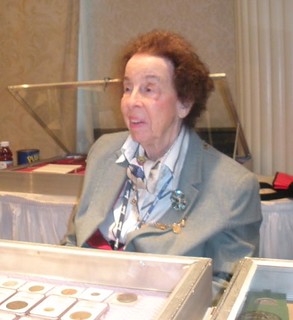 Catherine was a warm and sincere person. She was kind, understanding and so friendly.
Catherine was a warm and sincere person. She was kind, understanding and so friendly.
I remember walking the ANA Convention aisles in San Diego. Must have been 1983. It was my first ANA convention as director of the Bureau of Engraving and Printing. My wife was with me. Catherine came from behind her bourse table and greeted us warmly. I was surprised at meeting such a genuine person. The three of us went for coffee.
Catherine devoted considerable time explaining the intricacies of coin shows to my wife--how the bourse worked, auctions and the caliber of dealers and collectors. Then Catherine took us on a personal tour of the bourse floor. What a tour - so many dealers saluted us as we walked by, knowing that it was Catherine who was our guide.
A year later when our daughter was born, Catherine was the first to ask how she was. Catherine always sought out my wife or myself to ask how we were, how our daughter was, and, did we need anything. Catherine's warmth was not about numismatics, but something personal. A glowing warmth and genuine concern about how you were. And, what could she do for you.
In retrospect, Catherine's genuine and personal qualities, made her such a beloved person and successful and respected numismatist and dealer.
Rest In Peace, Catherine!
Jeff Rock of San Diego writes:
I was saddened to hear of the passing of Catherine Bullowa-Moore. A very fine woman, and one who knew her stuff and knew it well. I remember seeing her at a show in the early 1980's and she had a couple of rather rare colonial coins in her case, including a lovely nearly Uncirculated Pine Tree Shilling -- priced fairly, but well out of my league as a late-teenager. A rather slick gentleman tried to convince her that they were fakes and worth only a few dollars, obviously thinking she didn't know much about coins and he might scare her into selling them.
She then went into detail about what they were, which books they were plated in and described in and noted that she had owned them for over a quarter of a century. The man withered in defeat and the smile she flashed afterwards could easily have been read as "don't mess with me boys, this isn't my first time at the rodeo."
While the hobby is definitely still male-dominated, she showed that anyone who put their mind to it, did the work required to learn something about coins and treated people fairly and with integrity could make it! There wasn't an "Old Boy's Club" that wouldn't have loved to have her as a member!
To read the earlier E-Sylum article, see:
CATHERINE BULLOWA-MOORE (1919-2017) (http://www.coinbooks.org/v20/esylum_v20n21a09.html)
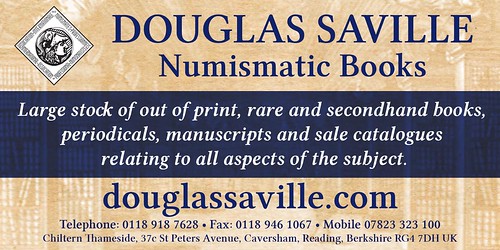
COINSWEEKLY BIOGRAPHY: KERRY WETTERSTROM
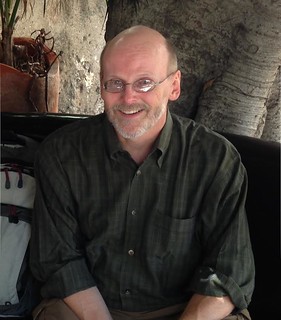 Kerry K. Wetterstrom (*1960) holds a bachelor degree in Petroleum and Mechanical Engineering from the University of Colorado. From 1987 to 1999, he was the Auction Director for Classical
Numismatic Group (CNG) before taking over as the editor / publisher for “The Celator”. In 2013, he returned to CNG as a staff numismatist.
Kerry K. Wetterstrom (*1960) holds a bachelor degree in Petroleum and Mechanical Engineering from the University of Colorado. From 1987 to 1999, he was the Auction Director for Classical
Numismatic Group (CNG) before taking over as the editor / publisher for “The Celator”. In 2013, he returned to CNG as a staff numismatist.
Aside from various numismatic activities from quite early on, Kerry K. Wetterstrom has been Education Chairman for the New York International Numismatic Convention (NYINC) since 2000. He has testified twice before the Cultural Property Advisory Committee (CPAC) at the U.S. State Department on the subject of restrictions on importation of numismatic materials.
He is a member of several organizations, including the American Numismatic Association and the Ancient Coin Collectors Guild of which is he President-elect (2016-2018). Since 2000, he has served as Corresponding Secretary of the Pennsylvania Association of Numismatists. He is a fellow of the American Numismatic Society and the Royal Numismatic Society. Also, he is a lifelong member of the Society of Paper Money Collectors and the Royal Canadian Numismatic Association, among others.
To read the complete article, see:
Kerry K. Wetterstrom
(http://www.coinsweekly.com/en/Numismatic-Whos-Who/Kerry-K--Wetterstrom/42?&id=81#)
For a free subscription to CoinsWeekly, see: http://www.coinsweekly.com/en/Subscribe-to-CoinsWeekly-Newsletter/37
ERIC P. NEWMAN CELEBRATES 106TH BIRTHDAY

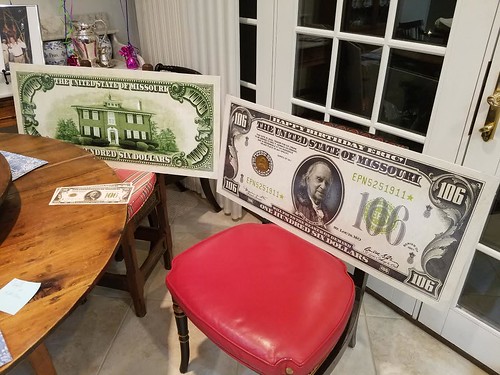
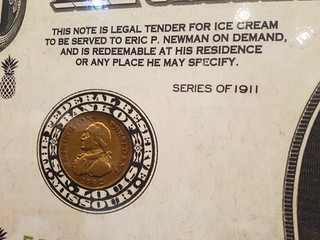
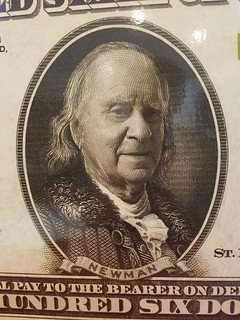
David Gladfelter writes:
Belated birthday wishes to you, Eric. You continue to remind us of George Will's comment about the standouts of professional baseball: "Some men are like mountains: The closer you get to them, the bigger they become."
Neil Shafer writes:
During the years Ruth Hill was active, virtually until the day she died, I was in constant contact with her. She lived in a large apartment in St. Louis. Much of the time we dealt with International Bank Note Society (IBNS) business, but there was also considerable discussion about the world paper money catalog originated by Dr. Arnold Keller, and which she eventually purchased from Whitman. Several sections were published under auspices of the IBNS.
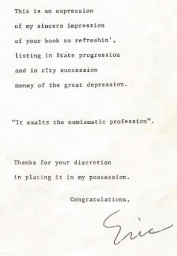 On two occasions I took one or the other of my 9 or 10-year-old young boys (now almost 52 and 50 years old) on a combined trip to see her and spend some time at Six Flags (or whatever the
big amusement park was named). After we returned from the amusement park we three would meet Eric for dinner- and invariably the boys would fall asleep at the table!
On two occasions I took one or the other of my 9 or 10-year-old young boys (now almost 52 and 50 years old) on a combined trip to see her and spend some time at Six Flags (or whatever the
big amusement park was named). After we returned from the amusement park we three would meet Eric for dinner- and invariably the boys would fall asleep at the table!
In 1974 Eric sent me a small round rubber blank "coin" that he said was used as a 1c substitute in St.Louis; this was during the time of the so-called "penny shortage" when several pieces of 1c scrip were issued. We had a kindred interest in those pieces.
In 1985 I sent Eric a Presentation Copy of my depression scrip book. His poetic response is illustrated.
I wish Eric the very best always.
To read the earlier E-Sylum article, see:
HAPPY BIRTHDAY #106, ERIC P. NEWMAN (http://www.coinbooks.org/v20/esylum_v20n21a11.html) 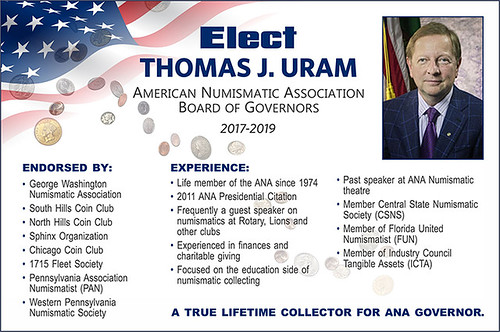
PROBLEMS WITH RIO OLYMPICS ECO-FRIENDLY MEDALS
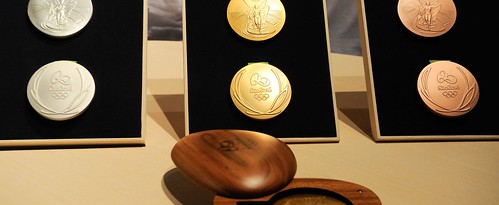
More than 100 eco-friendly Olympic medals won at the Rio Games last year have been sent back because they are rusting and decaying. The medals were hailed as a masterpiece of sustainability because they used recycled materials in place of traditional precious metals.
However, less than 12 months after they were handed out, a substantial number of the prizes are already the worse for wear.
About 150 of the medals – particularly bronze ones – have gone wrong since the games ended last August, Brazilian officials have acknowledged.
Athletes report that the items – which likely symbolize the greatest achievement of their lives – have started to flake, rust and develop small black spots.
Environmental advocates were thrilled with the original medals for their green credentials.
Bronze medals were partially made from copper industrial waste, while the “gold” medals are actually recycled silver, plated with 0.2 ounces of actual gold, accounting for 1.2% of its total weight.
However, they seem to be struggling to stand the test of time.
Some athletes reported that they had stopped letting people handle their medals for fear they will tarnish further.
One told The Times of London: “If I’m out showing my medal to kids, I try not to give them that one to touch in case it gets worse. I tend to let them hold my London [2012] one, as it is much better.”
It is not absolutely clear whether the production materials led to the increase in tarnishing – though the issue has not arisen among medals from previous games.
Is it a coincidence that the medal's container looks like a wooden toilet seat? Just sayin'
In fairness, of course, there has to be a first time for everything, and some problems are inevitable. But I'm confident the problems with the materials can be overcome in time. -Editor
To read the complete article, see:
Dozens of Eco-Friendly ‘Sustainable’ Rio Olympics Medals Returned Because of Rust,
Decay (https://heatst.com/world/dozens-of-eco-friendly-sustainable-rio-olympics-medals-returned-because-of-decay/)
To read the earlier E-Sylum article, see:
2016 RIO OLYMPICS MEDAL DESIGNS (http://www.coinbooks.org/esylum_v19n26a27.html)
SAWYER NATIVE AMERICANS MEDAL GALVANOS
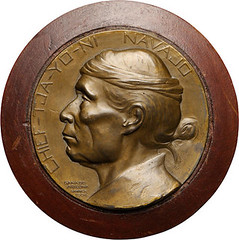
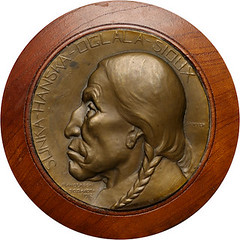
Lots 264, 265
Lot 264: GALVANO OF CHIEF-TJA-YO-NI NAVAJO
EDWARD WARREN SAWYER, GALVANO OF CHIEF-TJA-YO-NI NAVAJO
70 mm diameter, 93 mm diameter with frame. CHIEF-TJA-YO-NI NAVAJO around. At bottom left, GANADADO/ARIZONA/SAWYER/1904. One of the most famous medal series, but also one that no collector owns, is
the series of Indian bas-relief portraits by sculptor Edward Warren Sawyer. The series is known simply as "Sawyer's Indians." They are known only in museums!
Sculptor Edward Warren Sawyer (1876-1932) in the early years of the 20th century traveled to the American West to live among the tribes of the American Indians. His goal was to capture portraits of prominent Indians. This was not an easy task as the Indians believed such reproductions also captured their spirit, thus they disliked, even prohibited, being photographed. Sawyer had to first gain their confidence – by living amongst them – then gently urging his chosen model to sit for him. Perhaps that action didn't seem to extract the sprit from the body he was modeling with his clay. It was not like a photograph. His subject could see the slow progress in replicating his features and his adornment in the slowly mounting clay. The result is a body of work unlike any other in American history or portraiture! Sawyer captured more than forty Indian images in highly realistic glyptic detail. They are preserved in two American museums – The Smithsonian Institution in their Numismatic Division Collections, and the American Numismatic Society – but notably, neither has the complete series,
To read the complete lot description, see:
EDWARD WARREN SAWYER, GALVANO OF CHIEF-TJA-YO-NI NAVAJO (https://www.bonhams.com/auctions/24153/lot/264/)
Lot 265: GALVANO OF SUNKA-HANSKA-OGLALA-SIOUX
EDWARD WARREN SAWYER GALVANO OF SUNKA-HANSKA-OGLALA-SIOUX
70 mm medal, 93 mm diameter with frame. Obverse inscribed SUNKA-HANSKA-OGLALA-SIOUX around. Below left, MANDERSON/SO.DAKOTA/1912. To right, SAWYER. Housed in old wooden custom circular frame.
Edward Warren sawyer was a prominent sculptor and medalist born in Chicago March 17, 1876. He moved to Paris in 1912 and died in Toulon, France July 16, 1932. He is noted for preparing more than forty American Indian "bas-reliefs" from 13 Indian tribes. This example is one of a number of reliefs produced by the Medallic Art Company in galvano form for the artist. Sawyer exhibited five of these reliefs at the National Academy of Design, 1907, and nine at the International Exhibition of Contemporary Medals at the American Numismatic Society, 1910. One of his Sioux Indian Portraits was exhibited at F.I.D.E.M. Stockholm AF6 {1955} but the exhibit catalog did not specify which of the three Sioux portraits was shown. In 1931, he was awarded the J. Sanford Saltus Medal for Medallic Art by the ANS. (About Uncirculated)
To read the complete lot description, see:
EDWARD WARREN SAWYER GALVANO OF SUNKA-HANSKA-OGLALA-SIOUX (https://www.bonhams.com/auctions/24153/lot/265/)
To read the earlier E-Sylum articles, see:
ANS PUBLISHES EDWARD SAWYER’S NATIVE AMERICANS MEDALS ONLINE (http://www.coinbooks.org/esylum_v16n46a12.html)
MORE ON EDWARD SAWYER'S INDIAN MEDALS (http://www.coinbooks.org/esylum_v16n47a16.html) 
HERITAGE JUNE 2017 HONG KONG SALE SELECTIONS
Lot 37035: Chekiang. Kuang-hsü silver-plated copper Specimen Dollar
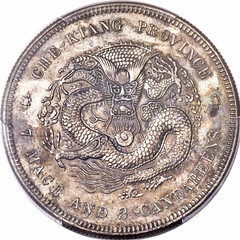
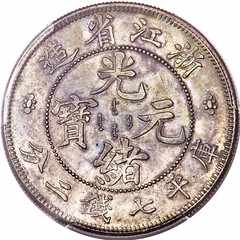
Possibly Unique Silver-Plated Copper Chekiang Pattern Dollar
Chekiang. Kuang-hsü silver-plated copper Specimen Dollar ND (1902) SP62 PCGS, same type as KM-Pn7 (silver strike) and KM-Pn8 (copper strike), type of L&M-277, type of Kann-119I, reverse rotated
180 degrees. Birmingham Pattern, with the province spelled CHE-KIANG rather than the spelling CHEHKIANG seen on the Hangchow mint coins. Superbly struck, with mottled russet and gray toning. An
exceedingly rare Pattern issue, with only a single example certified by PCGS. We can find no reference of another silver-plated copper piece. Possibly Unique? One of the true rarities of China
numismatics.
Ex. Li Da Wei Collection
To read the complete lot description, see:
China: Chekiang. Kuang-hsü silver-plated copper
Specimen Dollar ND (1902) (https://coins.ha.com/itm/china/world-coins/china-chekiang-kuang-hsu-silver-plated-copper-specimen-dollar-nd-1902-sp62-pcgs-/a/3055-37035.s)
Lot 37036: Chekiang. Kuang-hsü copper Specimen Dollar
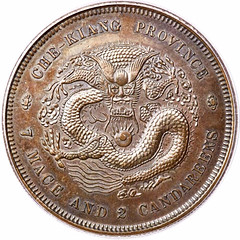

Extremely Rare Chekiang Copper Pattern Dollar
Chekiang. Kuang-hsü copper Specimen Dollar ND (1902) SP62 Brown PCGS, KM-Pn8, type of L&M-277, type of Kann-119I. As with the silver-plated copper piece offered in the previous lot, this example
has the reverse rotated 180 degrees. This coin is also a Birmingham Pattern, with the province spelled CHE-KIANG rather than the spelling CHEHKIANG seen on the Hangchow mint coin. The strike is
superb, with cordovan toning, and surfaces displaying only minor marks. Exceedingly rare, with only one other example certified by PCGS and both pieces Specimen 62.
Ex. Li Da Wei Collection
To read the complete lot description, see:
China: Chekiang. Kuang-hsü copper Specimen Dollar ND
(1902) SP62 Brown PCGS,... (https://coins.ha.com/itm/china/world-coins/china-chekiang-kuang-hsu-copper-specimen-dollar-nd-1902-sp62-brown-pcgs-/a/3055-37036.s)
Lot 37053: Hupeh. Kuang-hsü "Small Characters" Tael
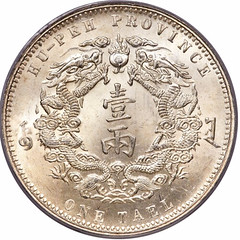

Hupeh. Kuang-hsü "Small Characters" Tael ND (1904) MS64 PCGS, KM-Y128.2, L&M-180. Small Characters variety. Exceptional quality for this coveted issue, which showcases original satin luster, with little tone on either side and sharply detailed raised surfaces that are free of distracting contact marks. While the "small characters" type is the more available of the two, this piece is among the most exceptional we have seen, and is tied for the finest graded example we've offered.
To read the complete lot description, see:
China: Hupeh. Kuang-hsü "Small Characters" Tael ND
(1904) MS64 PCGS,... (https://coins.ha.com/itm/hupeh/world-coins-china/china-hupeh-kuang-hsu-small-characters-tael-nd-1904-ms64-pcgs-/a/3055-37053.s)
Lot 37154: 1921 Republic Hsu Shih-chang gold "Pavilion" Dollar

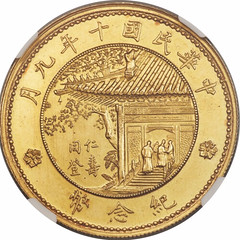
Republic Hsu Shih-chang gold "Pavilion" Dollar Year 10 (1921) MS64 NGC, Tientsin mint, KM-Pn62, Kann-1570, L&M-1093. Obv. 3/4 facing bust of President Hsu Shih-chang. Rev. Entrance to Pavilion in circle, Legend above reading, in Chinese characters, "Chinese Republic, 10th Year, 9th month," legend below in Chinese characters, "Commemorative Coin." Issued to commemorate General Hsu Shih-Chang's succession to the office of President, albeit three years late in its striking. A stunning example of this rare gold issue, fully lustrous with few surface abrasions worth mentioning. A number of die maintenance lines are present in the fields and should not be confused with cleaning hairlines. A remarkable piece.
To read the complete lot description, see:
China: Republic Hsu Shih-chang gold "Pavilion"
Dollar Year 10 (1921) MS64 NGC,... (https://coins.ha.com/itm/china/world-coins/china-republic-hsu-shih-chang-gold-pavilion-dollar-year-10-1921-ms64-ngc-/a/3055-37154.s)
THE BOOK BAZARRE
HISTORY OF THE KWIK LOK BREAD TAG COMPANY
Here's a totally non-numismatic interlude, but one that may be of interest to the history-minded among us. Last week we discussed Harry Waterson's unusual exhibit from the Central States Numismatic Society show featuring his classification scheme for Bread Tags, a free and fun item for the manic collector looking for something inexpensive to study.
Do other bloggers read ours? it's a freaky coincidence to see this just a week after writing about Harry's research. -Editor
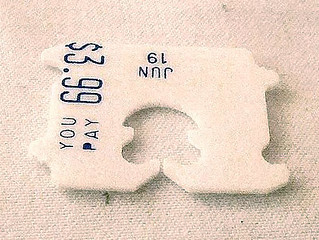 BREAD CLIPS! CONSIDER THEM FOR a moment, if you will. They’re those flat pieces of semi-hard plastic formed into a sort of barbed U-shape—you know the ones. They can be found keeping bread
bags all over the world closed and safe from spoilage, smartly designed to be used and reused. They’re all around us, constantly providing an amazing service, and yet still, they’re taken for
granted. And it turns out they’re almost exclusively all produced by a single, family-owned company.
BREAD CLIPS! CONSIDER THEM FOR a moment, if you will. They’re those flat pieces of semi-hard plastic formed into a sort of barbed U-shape—you know the ones. They can be found keeping bread
bags all over the world closed and safe from spoilage, smartly designed to be used and reused. They’re all around us, constantly providing an amazing service, and yet still, they’re taken for
granted. And it turns out they’re almost exclusively all produced by a single, family-owned company.
Kwik Lok, based in Yakima, Washington, has been manufacturing these little tabs ever since their founder whittled the first one from a credit card.
See there! A numismatic connection after all! -Editor
Without giving specific numbers, Kwik Lok says that they sell an almost unimaginable number each year. “It’s in the billions,” says Leigh Anne Whathen, a sales coordinator for the company, who says she personally prefers plastic clips to their natural enemy, the twist tie, because they last longer.
Floyd Paxton, Kwik Lok’s founder, was a second-generation manufacturing engineer who began his career working alongside his father, Hale, producing nail machines during World War II. Prior to the post-war plastics boom, both Paxton and his father produced, among other things, the nails used to close wooden boxes of fruit. In other words, package sealing was in Paxton’s blood.
According to the Kwik Lok website, the idea for the bread clip came to Paxton during a flight in 1952. As the story goes, while he was on the plane, Paxton was eating a package of complimentary nuts, and he realized he didn’t have a way to close them if he wanted to save some for later. As a solution, he took out a pen knife and hand-carved the first bread clip out of a credit card (in some tellings, it was an expired credit card).
Paxton established the Kwik Lok Corporation in 1954 in California, and quickly set out to popularize the tabs (now known officially as Kwik Lok Closures) by using them to close bags of apples. The company eventually moved to Washington state, where their headquarters are still located.
According to Whathen, Kwik Lok secured a patent on their little innovation in the early days of the company, and to this day, Kwik Lok remains one of the only manufacturers of bread clips in the world. Whathen says that the only other firm she’s aware of is a European competitor called Schutte.
To read the complete article, see:
Most of the World’s Bread Clips Are Made by a Single Company
(http://www.atlasobscura.com/articles/bread-tabs-clips-paxton)
To read the earlier E-Sylum article, see:
BREAD TAG BONANZA (http://www.coinbooks.org/v20/esylum_v20n21a28.html)
FAKE 1974 ALUMINUM CENTS OFFERED ON EBAY
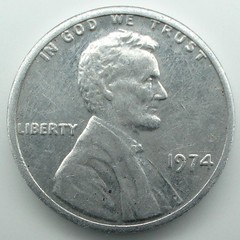

Fake 1974 Aluminum cent

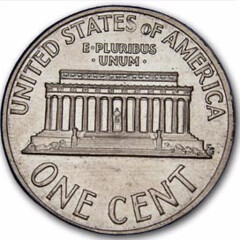
Genuine 1974 Aluminum cent
I bought it because it struck my fancy. There wasn't much chance that it was real, but it's a pretty obscure piece to fake and the seller clearly wasn't trying to hype it. I don't like encouraging counterfeiters in the abstract. On the other hand, there really wasn't any reason not to bid for under $5 delivered. I was expecting a plated piece from a seller who assumed that anything "white" had to be aluminum. I flipped out when I took it out of the envelope and saw it really was aluminum. Then I calmed down when I looked at it more closely. It was a fun little bit in the middle there. :-)
It weighs 1.005 grams, so it's definitely not copper. Unfortunately, it's also definitely not authentic. The dies are HEAVILY polished, with massive detail loss across the board. Look especially at Lincoln's coat, which blends into the field. There is no sign of VDB initials on the truncation of the bust. None of these features match the example in the Smithsonian.
Additionally, all of the lettering has a "mushy" or "pitted" quality that is never seen on US Mint products. There are good pictures of the real 1974 aluminum cent in The Authoritative Reference On Lincoln Cents by Wexler and Flynn
I think this is a spark erosion counterfeit, where the surface of the die was polished smooth to remove the pitting in the fields. That polishing removed much of the details, and wasn't able to remove the pitting from the design elements that were recessed on the die. Once you have counterfeit dies at all, you can strike them on anything.
I wonder if whoever made it knew what he was doing, or if it was an accident that he ended up with the one date where an aluminum cent would have mattered.
Now that I have this one, I see several other similar listings. I probably wouldn't have paid even the $5 if I was aware of the others. Bad on me for not doing my research first, although I still don't mind for $5. I do feel a little bad for whoever paid $200+ for the similar listing cited in the thread on the PCGS boards and in the Coin World article.
To read the complete article, see:
Recent eBay win by a collector is a fake 1974 aluminum cent
(http://www.coinworld.com/news/us-coins/2017/05/1974-aluminum-cent-fakes-appear-in-bay-sales.html)
To read the complete lot description, see:
USA America - Liberty Lincoln 1 Cent 1974 Aluminium Ungewöhnlich (http://www.ebay.com/itm/112384155743)
To read the Collectors.com discussion forum, see:
I just bought a 1974 aluminum Lincoln cent on eBay
(https://forums.collectors.com/discussion/981202/i-just-bought-a-1974-aluminum-lincoln-cent-on-ebay)
To read the Smithsonian article, see:
UNITED STATES, 1 CENT, 1974 (ALUMINUM)
(http://amhistory.si.edu/coins/printable/coin.cfm?coincode=3_01&coinside=front)

ANS REPATRIATES LOOTED COINS TO SALZBURG MUSEUM

Dr. Lechenauer, Dr. Wartenberg and Dr. Hochleitner
The American Numismatic Society (ANS) welcomed the Director and CEO of the Salzburg Museum, Direktor Hon.-Prof. Mag. Dr. Martin Hochleitner, Consul General of the Austrian Consulate in New York Dr. Georg Heindl, and Dr. Peter Lechenauer, an attorney representing the Salzburg Museum, to New York for the repatriation of a group of 94 coins stolen from the Salzburger Museum Carolino-Augusteum in 1945. The coins were turned over to Dr. Hochleitner and Dr. Lechenauer by Mr. Kenneth L. Edlow, Chairman of the Board of Trustees of the ANS, and Dr. Ute Wartenberg, Executive Director of the ANS, on Friday, May 26, 2017.
This group of coins came to the ANS in 1995 after our late Benefactor, Mr. Chester L. Krause, brought them to the attention of the curators. Mr. Krause had learned that these coins were rumored to have come from a museum in Austria in 1945 and donated to the ANS the funds to purchase them, so as to ensure that they could be returned to any rightful owner rather than being dispersed on the market.
In the last year of World War II, the coins from the Salzburger Museum Carolino-Augusteum were moved to underground storage for protection. After the end of the war, the American occupation authorities took custody of the coins; when they were returned to the museum in 1946, over 2,000 coins were missing.
After the ANS acquired the 94 coins in 1995, curators began investigating whether they could have been among the coins stolen in 1945–46. Recent work has been able to match a few coins with earlier photographs and many others, which have inventory numbers written in ink on the surface of the coin, with an old card file in the Salzburg Museum bearing similar numbers. This work has demonstrated that the group of coins can in fact be identified as a small but valuable portion of the coins stolen over 70 years ago.
These coins represent an important body of material for the study of the history of Salzburg and Austria. Highlights include a gold florin of Archbishop Pilgrim II of Salzburg (1365–1396), a silver pfennig of the same archbishop, a silver pfennig of Archbishop Hartwig of Salzburg (991–1023), and a Bohemian groschen of the years around 1400 that was counter-stamped for validation by three different cities, Nördlingen, Ulm, and Salzburg. The ANS is pleased to have assisted with their return home.
Executive Director Dr. Ute Wartenberg commented on the return of the coins to Austria: “We are delighted that these interesting coins will be returned to the museum where they belong and where people will view and study them. I am also so grateful to the late Chet Krause for his extraordinary initiative in trying to preserve Austrian heritage. A case like this one illustrates that even today museums in the US should be acting perhaps as safe havens for looted objects and be more proactive in acquiring looted objects with the specific purpose to eventually repatriate them.”
Thanks and congratulations to the late Chet Krause, the ANS and all involved for a job well done.
The article doesn't mention whether the source of the coins was traced to learn the identity of the looter(s). Unfortunately, that evidence tends to get lost to time. It's a disgrace that the looting occurred, but I'm heartened know that at least some of the coins have been returned to their proper owner.
I'd like to highlight an important aspect of the numismatic sleuthing that made this repatriation possible. The ANS has an open-access policy and makes electronic versions of its publications freely available on the internet. Here's a passage from the accompanying blog article with images of some of the coins. -Editor
Open-access publication of old ANS annual reports has made them much more widely available, and this brought the story to the attention of more numismatists in Austria. As a result, recent work has been able to match a few coins with earlier photographs and many others, which have inventory numbers written in ink on the surface of the coin, with an old card file in the Salzburg Museum bearing similar numbers. This work has demonstrated that the group of coins can in fact be identified as a small but valuable portion of the coins stolen from the Salzburger Museum over 70 years ago.
These coins represent an important body of material for the study of the history of Salzburg and Austria. Highlights include a gold florin of Archbishop Pilgrim II of Salzburg (1365–1396), a silver pfennig of the same archbishop, a silver pfennig of Archbishop Hartwig of Salzburg (991–1023), and a Bohemian groschen of the years around 1400 that was counter-stamped for validation by three different cities,

Silver pfennig, Salzburg 1365-1396

Silver groschen, Bohemia, 1378–1419

Gold florin, Salzburg (Austria), 1365–1396
In response to my question about the above photo, Dr. Ute Wartenberg Kagan adds:
We (Dr. Peter Lechenauer, attorney and coin collector, me, and Dr. Martin Hochleitner, director of the Salzburg Museum) are holding the signed agreement to return the coins to the Salzburg Museum. Note that many of the very rare losses from this episode include a famous Rübentaler, of which only seven are known; it is still missing today.
To read the complete press release, see:
ANS Repatriates Stolen Coins to Salzburg Museum (http://numismatics.org/salzburgpr/)
For more information, see the ANS Pocket Change blog article:
ANS TO REPATRIATE 94 WAR-LOOTED COINS TO THE SALZBURG MUSEUM (http://numismatics.org/pocketchange/salzburg/)

1765 RUSSIAN COIN FOUND ON NOVA SCOTIA BEACH
 Kieran Bent was looking for sea glass at the beach near his grandparents’ home in Abercrombie on Saturday when he saw a greenish object that caught his eye. “When I picked it up, it didn’t
feel right based on its thickness,” Bent said.
Kieran Bent was looking for sea glass at the beach near his grandparents’ home in Abercrombie on Saturday when he saw a greenish object that caught his eye. “When I picked it up, it didn’t
feel right based on its thickness,” Bent said.
He gave it a flick and the sound was more like metal.
“Then I remembered that copper corrodes green,” the 15-year-old said.
Bent, who lives in Trenton, realized his find might be a coin, but he wasn’t sure.
After about four hours of cleaning it, he was able to see letters and the date 1765 clearly visible on one side, allowing him to try to identify it online.
He learned that it’s a five kopek coin from the old Russian Empire. Worn ones sell for around $25, Bent said. He said the one he found probably would have been worth more if he hadn’t cleaned it, because collectors advise against that.
Local coin collector and expert Steve Brennan said a Russian coin certainly wouldn’t be common in this area.
“I don’t know how it would have landed on a beach,” he said.
Coins most often end up on a beach when people are carrying them in their pocket and changing to swim, he said. It’s possible someone was visiting from Russia or had visited and gave the coin to someone in Pictou County. Given the age of the coin, it’s also possible it came from a ship that sank in the area or was passing through the area and someone dropped it. There’s a place near the Abercrombie beach on the East River, which is a tidal river, where coal ships were loaded many years ago.
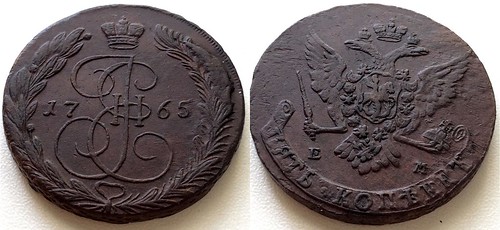
To read the complete article, see:
Teen discovers 18th century Russian coin on Pictou County beach
(http://www.ngnews.ca/news/local/2017/5/25/teen-discovers-18th-century-russian-coin-on-pictou-county-beach.html)
To read the earlier E-Sylum article, see:
THE 1797 RECOINING PROGRAM OF CZAR PAUL I OF RUSSIA (http://www.coinbooks.org/esylum_v19n08a30.html)
17TH CENTURY GOLD COIN FOUND IN MOSCOW RIVER
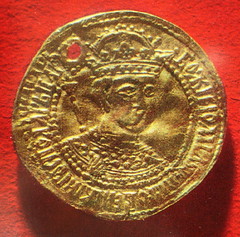 A 400-year-old gold coin worth over $17,000 was found by an amateur treasure hunter at the bottom of the Yauza River in Moscow.
A 400-year-old gold coin worth over $17,000 was found by an amateur treasure hunter at the bottom of the Yauza River in Moscow.
This valuable discovery was found by an amateur diver who was sweeping the Yauza River bed with a search magnet; the coin was stuck to a metallic pivot buried deep within the silt.
The coin turned out to be a gold ugorsky chervonets minted during the reign of Russian Tsar Boris Godunov (1598-1605), TV channel Moscow 360 reports.
Such coins weren't used as currency but were issued as a reward for martial valor. It is considered extremely rare, as only six such coins have been found to date, and may be worth over $17,000.
Meanwhile, the lucky treasure hunter opted to remain anonymous, because per Russian legislation a person who engages in archaeological activities without proper authorization and inflicts damage to artifacts during the process may face a hefty fine and up to four years in prison.
To read the complete article, see:
Diver Finds 17th Century Gold Coin Worth $17,000 in Moscow River
(https://sputniknews.com/art_living/201705211053825947-priceless-coin-river-discovery/)
THE BOOK BAZARRE
MOSCOW IDAHO CHALLENGE COIN FOR SLAIN OFFICER
Jeff Starck of Coin World writes:
We’ve discussed the abundance of “challenge coin” issues in recent times before in The E-Sylum. Here is another report, about one from Idaho honoring an officer slain 10 years ago. The department gave the family 40 of the medals and is using them as award pieces.
 Ten years ago this month, a gunman opened fire near the courthouse in Latah County, killing four people, before ending his own life. One of the victims killed was Moscow Police Officer Lee
Newbill and now the department is remembering him in a special way.
Ten years ago this month, a gunman opened fire near the courthouse in Latah County, killing four people, before ending his own life. One of the victims killed was Moscow Police Officer Lee
Newbill and now the department is remembering him in a special way.
Military, emergency responders and law enforcement have a tradition of creating “challenge coins” which are coins that carry a special significance. Moscow Police Chief, James Fry, said they are made as a symbol of pride and honor.
Police Chief Fry said, "It's just an item that we can give to other law enforcement officers, or people that in the community, when they do something special or if they're involved in a special way they get a coin so that they just know that we appreciate what they've done."
And to remember the ten years that have passed since Officer Newbill was killed in the line of duty, the Moscow Police Department created this coin in his honor.
To read the complete article, see:
Coin made in the honor of Officer Newbill who paid the ultimate sacrifice
(http://klewtv.com/news/local/coin-made-in-the-honor-of-officer-newbill-who-paid-the-ultimate-sacrifice)
THE 1978 SOUTH KOREAN COMMEMORATIVE COIN RIOT
South Korean coin enthusiast Mark Lovmo of Minneapolis writes:
I've written a new article about South Korea's 42nd World Shooting Championships commemorative coins (KM #22 and #23), released in 1978. This was South Korea's second domestically-minted commemorative issue and was made for the International Sport Shooting Federation's shooting event hosted in Seoul that year.
Due to some interesting local circumstances at the time in Korea, the release of the silver commemorative caused a near riot. When was the last time that you've heard the sale of a commemorative coin attracted 20,000 people(!) to show up all at the same time?
 The story behind the manufacture and release of these two South Korean commemorative coins is a roller coaster ride of tight deadlines and inadequacies at the Mint; all thrown in with a
meddling big-shot friend of the president of the country. And if it had not been for a last-minute policy exception, the whole thing might not have happened at all. Such instability surrounding South
Korea’s commemorative coin production was apparently the modal state of affairs in the late 1970s. Leading up to the 1978 release of these coins, the Korean Mint was still quite new to advanced coin
manufacturing processes involving the production of high quality proof coins, and had particular problems in both engraving and in the creation of the critical pieces of tool steel for the
manufacture of the master dies. Despite the problems, the coins were released on schedule, and the silver coin of this series became an overnight sensation, making them some of the most popular
commemorative coins ever issued in South Korea.
The story behind the manufacture and release of these two South Korean commemorative coins is a roller coaster ride of tight deadlines and inadequacies at the Mint; all thrown in with a
meddling big-shot friend of the president of the country. And if it had not been for a last-minute policy exception, the whole thing might not have happened at all. Such instability surrounding South
Korea’s commemorative coin production was apparently the modal state of affairs in the late 1970s. Leading up to the 1978 release of these coins, the Korean Mint was still quite new to advanced coin
manufacturing processes involving the production of high quality proof coins, and had particular problems in both engraving and in the creation of the critical pieces of tool steel for the
manufacture of the master dies. Despite the problems, the coins were released on schedule, and the silver coin of this series became an overnight sensation, making them some of the most popular
commemorative coins ever issued in South Korea.
As the planning and design phase for the new commemoratives got underway, the Chairman for the shooting championships, Pak Jong-gyu, made an urgent request to the Bank of Korea that priority be given to the commemorative coins being made for the event that he was organizing. Pak strongly requested that the Mint redouble its efforts to have the Shooting Championships coins ready for release before June 1978 in order not to disrupt the distribution and marketing schedule for the coins. In response to this request, the Mint soon shifted the focus of its design work to preparing the shooting championships coins.
What followed, from March to July 1977, were five months of tedious back-and-forth consultations with Chairman Pak over the coin designs as the Bank of Korea and the Komsco team got bogged down attempting to satisfy the Chairman’s desires concerning the coins’ appearance down to the tiniest detail. Having a micromanaging third party inserting itself between the Komsco team and the Bank of Korea was an unusual and frustrating experience that required an extra effort on the part of the practitioners involved. Despite this difficulty, the design team finalized work on two designs that ultimately met with Pak’s approval.
By July 25th, the proposed coins also had the approval of the Governor of the Bank of Korea, Kim Sung-hwan. Governor Kim announced that two coins were to make up the Shooting Championships commemorative issue: A 2,500 Won silver coin featuring the image of the Muyong mounted archer, and a 500 Won coin displaying the design of the standing rifle competitor. The 2,500 Won Silver coin design was the work of senior Komsco designers Kang Bak and Jo Byung-soo, while junior designers, Ryu Taek-soo ( 류택수 ) and Lee Ye-soo ( 이예수 ) co-designed the images on the 500 Won coin.
During its final review of their event’s commemorative coin designs, the Shooting Championships committee requested a change to the coins’ planned diameter sizes and denomination. The Bank of Korea subsequently changed the specifications, enlarging the silver coin’s diameter from 32mm to 35mm, and the value from 2,500 Won to 5,000 Won. The denomination of the 500 Won coin remained unchanged but its diameter size was also increased, from 30mm to 32mm.
Minting and Release of the Coins
Beginning on April 7, 1978 and over the following two months, the Korean Mint struck the two Shooting Championships coins according to the mandated mintages and finishes for both coins. The Mint
determined that the cost per unit to mint the 5,000 Won silver coins was 3,849 won, 62 jeon each; and each of the 500 Won copper nickel coins cost 179 won, 10 jeon.
The minting of the Shooting Championships commemoratives saw the strictest quality-control measures applied to South Korean coins up to that time; and accounting for errors and damaged coins, 97.3% of the total coins of the official mintage were actually issued. These commemoratives were also unique in that the 5,000 Won coin was South Korea’s first domestically-minted, and locally-released, silver coin of legal tender. The Shooting Championships coins were also the first South Korean coins to be minted in two different proof finishes (proof and frosted proof), although the 500 Won commemoratives, most of which were minted as business strikes, made up the majority of the total coins.
Officials at the Bank of Korea intentionally limited the total mintage of both coins to 1.1 million; far fewer than the five million total coins minted for the South Korea’s first domestically-made commemorative coin, the 30th Anniversary of Liberation 100 Won coin that was released in 1975. That experience had taught them that issuing millions of commemorative coins in a country where citizens were not familiar with the concept of a “commemorative coin” was not exactly a recipe for success. In an effort to avoid repeating the mistake, currency planners had hoped to enhance the commercial value of the Shooting Championships coins by striking some of them in silver, and by keeping their numbers to a relatively smaller overall mintage while also striking a small minority of both coins in different proof finishes. Other promotional efforts included purposely marketing the coins to foreign visitors attending the shooting event, to other tourists visiting South Korea, and to collectors.
Coin Melee
It is hard to believe that the sale of a commemorative coin in South Korea could have had people lining up all along the street and around the corner. The release of the 42nd World Shooting
Championships 5,000 Won silver commemorative coin did just that.
At exactly 4 a.m. in the morning of the Bank of Korea’s 30th anniversary, Monday, June 12, 1978, numbers of people rushed to the Bank of Korea building from various corners of the surrounding neighborhood. They ran to queue up outside the front doors, released by the lifting of the citywide curfew (one that was enforced from midnight to 4 a.m. nightly in South Korean cities from September 1946 to January 1982). The crowd had flocked to purchase one of the six thousand 5,000 Won silver coins that were to be sold from the Bank building that day. The Bank’s remaining allotment of 12,000 silver coins, to be released the following day, were expected to attract an even larger crowd.
What would explain the public’s newfound interest in a commemorative coin when people seemed to have cared so little about them just a couple of years before? As South Korea placed severe restrictions on precious metals imports, the coin’s silver content probably had something to do with it, and that fact probably played into another phenomenon that was taking place at the time.
In 1978, many Koreans were benefitting from an improved economy, and some households were flush with cash from massive remittances sent home by Korean construction workers in Persian Gulf states, which had contracted Korean businesses to develop their infrastructure. Back in Korea, legal restrictions did not allow people many choices for investing any of this new money. Hard assets, such as land, were almost the only options. Indeed, the latter part of the 1970s was characterized by a real estate boom south of the Han River in Seoul in which farmers were becoming millionaires overnight by selling their once-inexpensive farmland to developers. The environment was ripe for the country to experience a “speculation craze.” Real estate was not the only area where this speculation fever existed. Precious metals were another. The coins became an instant magnet for investors when reports surfaced on June 12th about those lucky few who had purchased one of the new silver coins and then quickly sold it within minutes for a hefty profit.
So when the 4 a.m. curfew lifted the following morning, all hell broke loose at the Bank of Korea.
To read the complete article, see:
The 42nd World Shooting Championships Commemorative Coins (1978) (http://dokdo-research.com/42ndworldshooting.html)
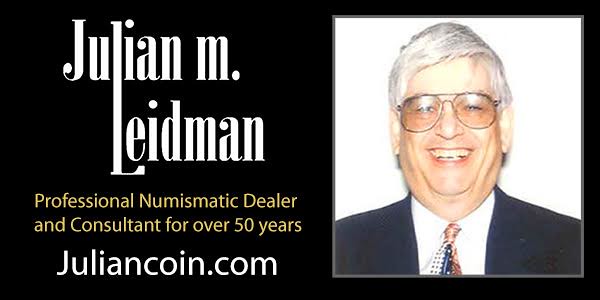
CHINESE PRACTICE NOTES CIRCULATED IN OHIO

Another area police department is warning people to be on the lookout for counterfeit money.
This time it's in the Ashtabula County community of Orwell where police recovered phony bills from two different businesses.
Police say the bills are similar to American currency, however, they are marked with Chinese lettering.
To read the complete article, see:
Counterfeit bills marked with Chinese letters being circulated
(http://www.wfmj.com/story/35493709/counterfeit-bills-marked-with-chinese-letters-being-circulated)
To read the earlier E-Sylum articles, see:
QUERY: $50 CHINESE "PRACTICE NOTE" (http://www.coinbooks.org/esylum_v14n25a14.html)
MORE ON CHINESE PRACTICE NOTES (http://www.coinbooks.org/esylum_v14n26a09.html)
IS JANE AUSTEN'S BANKNOTE PORTRAIT TOO PRETTY?
When the U.S. Susan B. Anthony dollar coin was released, there were complaints from the public about how ugly Anthony and the coin looked. The Mint staff had tried to depict a younger-looking Anthony in her prime, but her descendants complained that the designs didn't look like they remembered their old Aunt Susan. So the Mint made her look like an old lady.
A similar dynamic is playing out now following the release of the Bank of England's note picturing author Jane Austen. People are complaining that she's depicted as too pretty. Here's an excerpt from a Harper's Bazaar article. -Editor
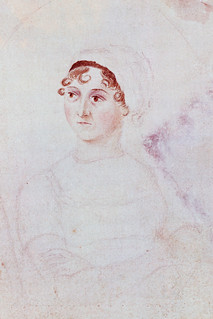
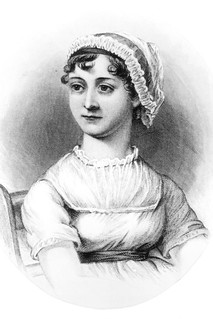
"Sour" Jane and "Airbrushed" Jane
It would seem that not even Jane Austen can escape airbrushing, even 200 years after her death. Campaigners have questioned why the Bank of England have used a "prettied-up publicity portrait" of the author on the new £10 note rather than a more realistic image of her.
The polymer note, which was unveiled in July, features a portrait of a sweet-looking, plump-cheeked Austen wearing a lace bonnet, reports The Sunday Times. The image was created in 1817 after the writer had died and was commissioned from a sketch by Austen's sister, Cassandra, in which the novelist looks shrew and cross.
"They presumably said to the artist, make it look prettier," said Austen biographer Paula Byrne. "It is like doctoring a selfie by a celebrity. It is such a shame because that demure image is just not Austen."
The decision to choose a "retouched" image of Austen has provoked anger.
"Jane Austen fans are pleased, obviously, that she's going to appear on the banknote, but it's deeply ironic that the image chosen by the Bank of England isn't really her," said historian Lucy Worsley, who recently published a book about the novelist.
"It's an author publicity portrait painted after she died in which she's been given the Georgian equivalent of an airbrushing — she's been subtly 'improved'.
"Jane had a much sharper face — some might call it sour. And she was a sharp person. I think of her as being like a bracing martini."

To read the complete article, see:
JANE AUSTEN AIRBRUSHED ON NEW £10 NOTE, SAY CAMPAIGNERS
(http://www.harpersbazaar.co.uk/culture/culture-news/news/a41642/jane-austen-airbrushed/)

SWAMPFUL OF OLD SOVIET BANKNOTES FOUND
 A group of explorers in Russia have found around a billion roubles in old Soviet money at an abandoned mine, but it's all completely worthless.
A group of explorers in Russia have found around a billion roubles in old Soviet money at an abandoned mine, but it's all completely worthless.
The group from Saint Petersburg, who publish a blog on abandoned sites across Russia, came across the money after following rumours that large quantities of cash had been dumped in old missile silos near Moscow after the collapse of the Soviet Union, the Komsomolskaya Pravda news website reports. After travelling for several hours across rough terrain in Russia's Vladimir region, they found the mine literally overflowing with cash.
The site contains an estimated one billion roubles ($18m; £13.5m at current exchange rates, or $33.3m at the "official" Soviet rate in 1991) in Soviet Union banknotes of various denominations issued between 1961 and 1991, all no longer legal tender in the Russian Federation. The mine had been flooded in recent years, leaving what was essentially a swamp of banknotes bearing the face of Vladimir Lenin, the explorers' YouTube channel shows.
According to their account of events, elderly locals told the team about the mine, but said that nobody dared go near the place because it was linked to the Soviet Union's ballistic missile programme, and contaminated with radiation. However, Geiger counters showed that this was not the case.
Team member Olga Bogdanova said that the sight of such "riches" was difficult to convey in words. "There's delight and some sadness, because you realise that this is a bygone era which will never return, that all this money would have been more than enough for anybody," she said. Just 100 roubles would have been a very good salary back in Soviet times.
The video has caught the imagination of social media users, many of whom wish that the cash was still legal tender. "I would dive in there like Scrooge McDuck," says one user, while another exclaimed, "I wish I could have a time machine, return with a pack of those banknotes and buy myself a controlling stake in Google, Gazprom, Rosneft, and never work again."

Eric Schena adds:
It is quite interesting to hear about huge quantities of money disposed of in a mine. That is something that is not uncommon in the coal scrip world. To give some perspective, the exchange rate prior to the collapse of the USSR was 1 ruble = $1.60. I went there in early January 1992 barely 3 days after Yeltsin lifted the old price controls. At the time that I arrived, the exchange rate was 100 rubles to the dollar and by the time I left 10 days later it was anywhere from 150 to 200 to the dollar and rising.
They had only just introduced the 200 ruble note and were rolling out the 500 the last couple of days I was there. Some of the fixed prices were still in effect, like the Moscow Metro was 15 kopecks. The old Soviet notes (1961 series) were still in use but were rapidly replaced by several different design types dated 1991. I got a mix of notes while there, including a pack of 10 ruble notes with a band from the State Bank dated 25 December 1991 - the day Gorbachev dissolved the Soviet Union.
To read the complete article, see:
Russian explorers find 'swamp' of Soviet money (http://www.bbc.com/news/blogs-news-from-elsewhere-40043311)
GUNMEN SEIZE TRUCKLOAD OF YEMENI BANKNOTES
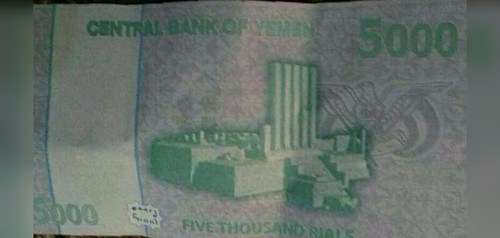
Tribal gunmen seized a truck carrying banknotes of 5,000 riyals category belonging to the Central Bank of Yemen in the al Rayyan desert east of al Jawf province in northeastern Yemen, a tribal source said.
The tribal source told Almasdaronline that the truck belongs to the Houthi group and former president Saleh's party, and was on the way to the areas under their control through the eastern desert of al Jawf.
He added that security patrols of the tribal militants in the areas under the control of the pro-government forces were the one who pursued and stopped the truck, and have identified the driver.
It is noteworthy that the Houthis have driven the economic situation to collapse, and a few days ago they applied the commodity card system to force government employees to receive only half of their salary, which has not been paid for the last eight months.
I thought I'd document this story for future banknote collectors - it's fascinating to follow the history of how money changes hands, which is sometimes at gunpoint rather than in commerce. It may never be possible to trace particular Yemeni banknotes to this reported robbery, but it's now part of the folklore.
It's also interesting to note the efforts of desperate governments to stretch their funds by forcing people into alternate payment schemes. It's never a movie that ends well. -Editor
To read the complete article, see:
Tribal gunmen seize a truck carrying “Yemeni banknotes” – source (http://www.almasdaronline.com/article/91509)
More than 7,600 people have been killed and 42,000 injured since March 2015, the majority in air strikes by a Saudi-led multinational coalition that backs the president.
The conflict and a blockade imposed by the coalition have also triggered a humanitarian disaster, leaving 70% of the population in need of aid.
To read the complete article, see:
(http://www.bbc.com/news/world-middle-east-29319423)
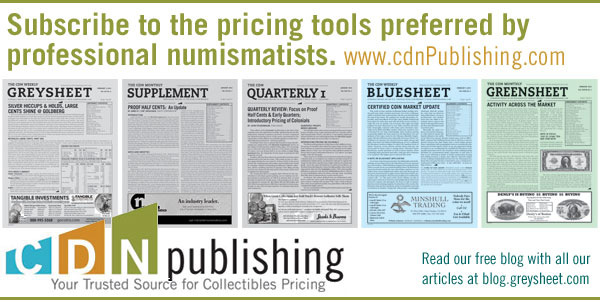
MAN BALANCES BANKNOTE ON NOSE
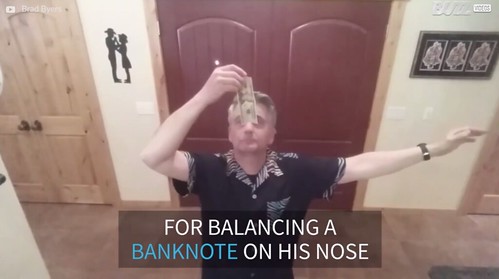
To watch the complete video, see:
Check out this guy's bank(note) balance!
(https://www.msn.com/en-ca/video/animals/check-out-this-guys-bank-note-balance/vp-BBBxFwF)
To visit Brad Byers' web site, see:
www.bradbyers.com

ART PROJECT PILES 15,000 COINS ON SIDEWALK
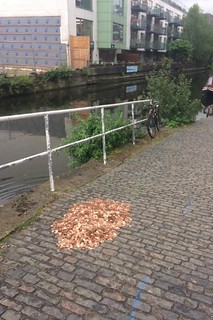 It was one of London's stranger social experiments - dump 15,000 2p coins on a towpath and then film what happens.
It was one of London's stranger social experiments - dump 15,000 2p coins on a towpath and then film what happens.
AirBnB host Jamahl McMurran and his guest Lana Mesic, a photographer, dreamt up the stunt to use up a mound of coins left over after being used in an art installation.
They bagged them up and hauled them down to the towpath on the Regent's Canal before setting up a camera in Mr McMurran's flat overlooking the area.
The pair got four hours of footage before they scheme came to a halt when two thieves turned up and swiped the £300 pile.
Before the theft, Mr McMurran and Ms Mesic caught on film a cyclist standing in the mound before picking a handful of coins up and tossing them over his head, and children playing in the pile.
Other people attempted to take as many coins as possible, including a teenage boy, but most were thwarted by their weight.
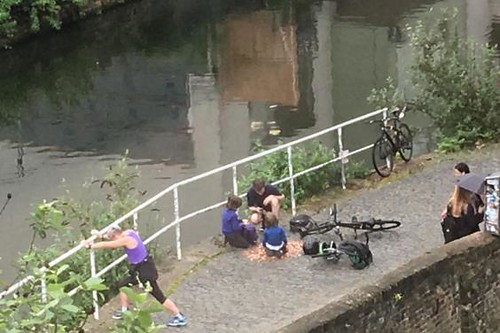
Mr McMurran, who works for investment firm Seedcamp, told the Standard he was “gutted” when the coins were taken so soon, but still thought the experiment had been “incredible”.
Ms Mesic, a Croatian artist now based in the Netherlands, had the coins leftover from an art installation and was struggling to find a way to transport them back to the Netherlands.
“I suggested putting them by the river as a joke one night over a drink and she genuinely started contemplating it,” explained Mr McMurran.
"It was completely spontaneous and we had no idea what would happen. Some of the footage is absolute hilarious, that one guy who stood in the coins is magical.
To read the complete article, see:
What happens when you leave 15,000 2p
coins by Regent's Canal as a social experiment... two thieves swipe them all
(http://www.standard.co.uk/news/london/passersby-frolic-in-mound-of-2p-coins-left-by-regents-canal-in-social-experiment-before-two-men-a3541671.html)

